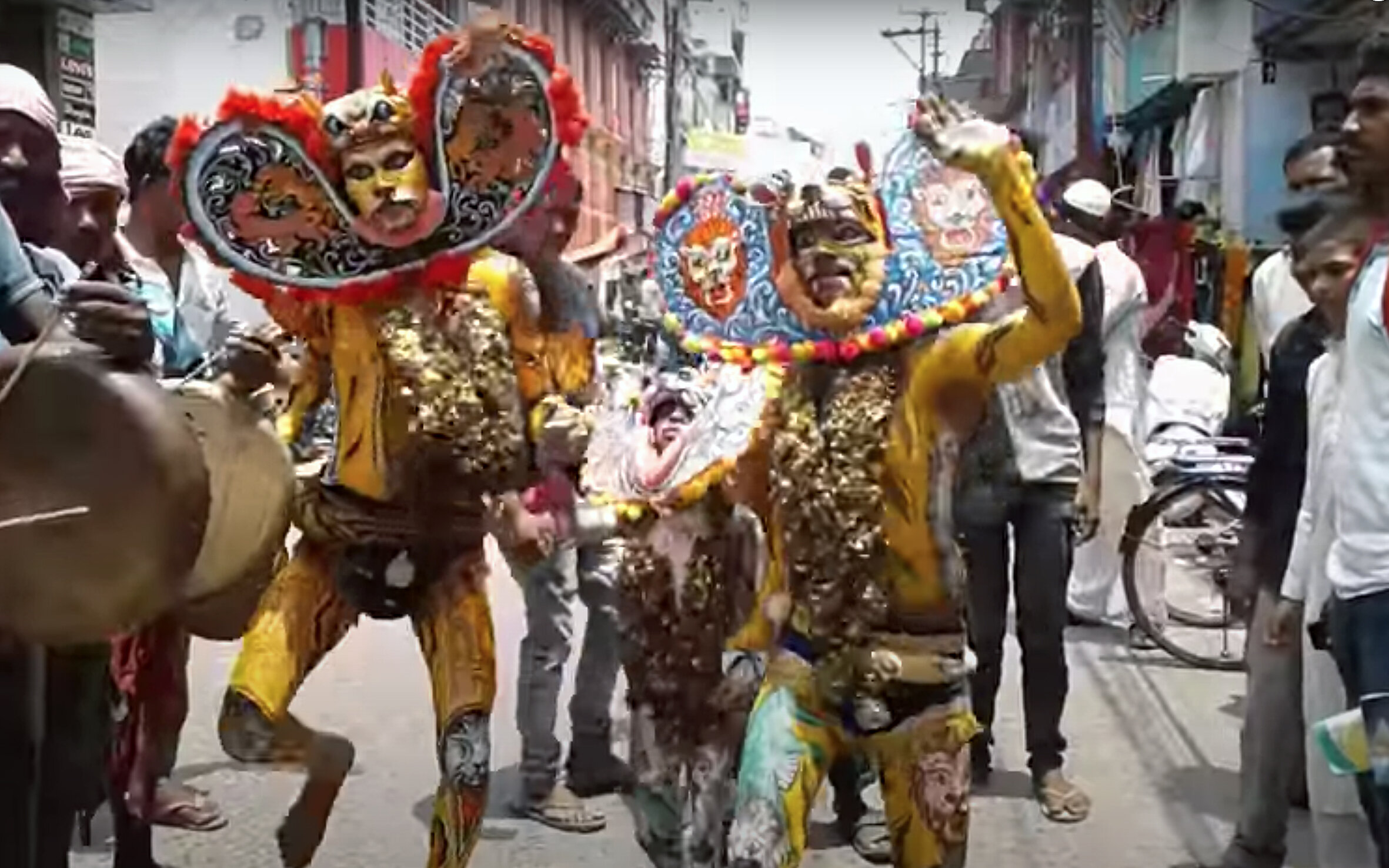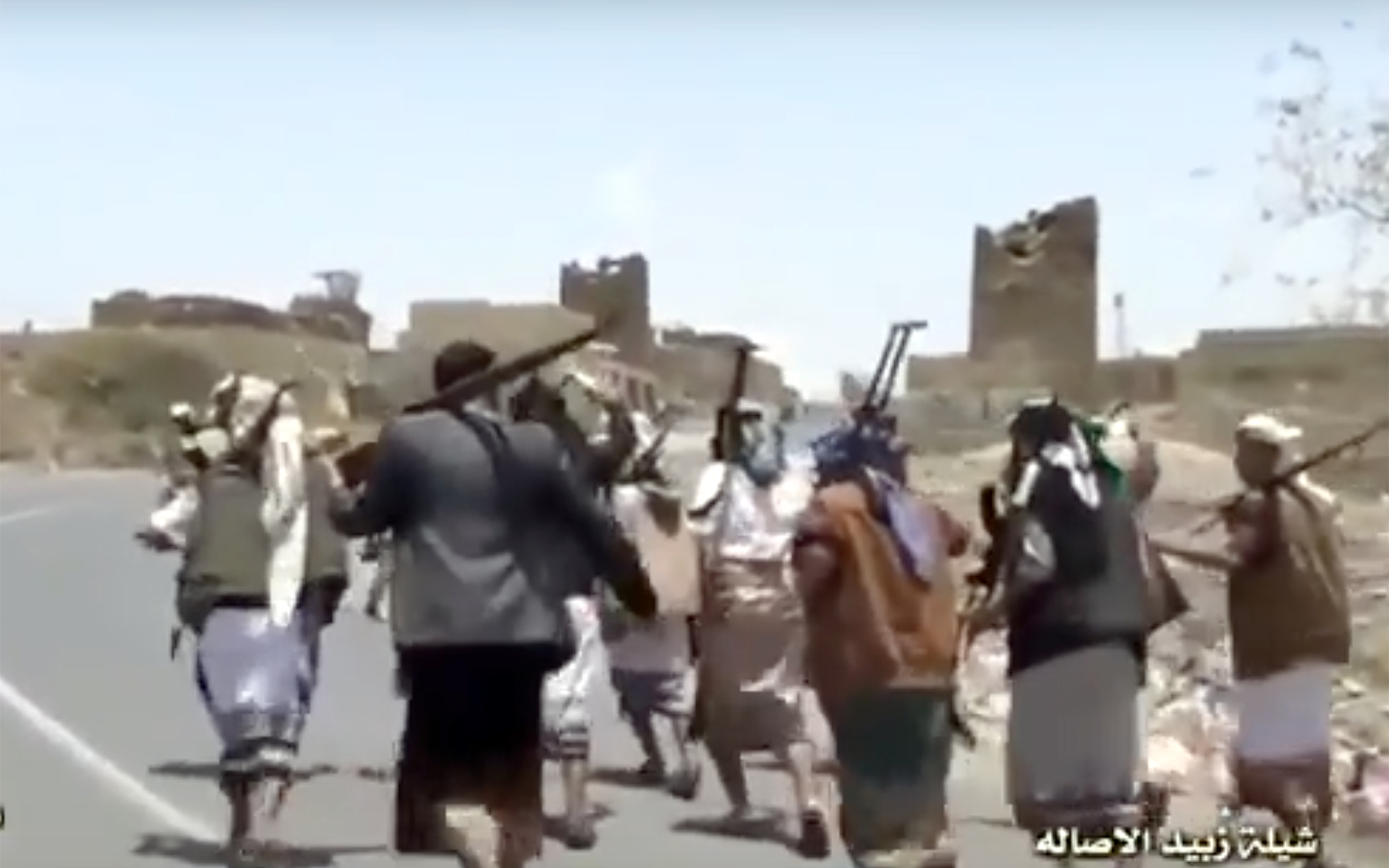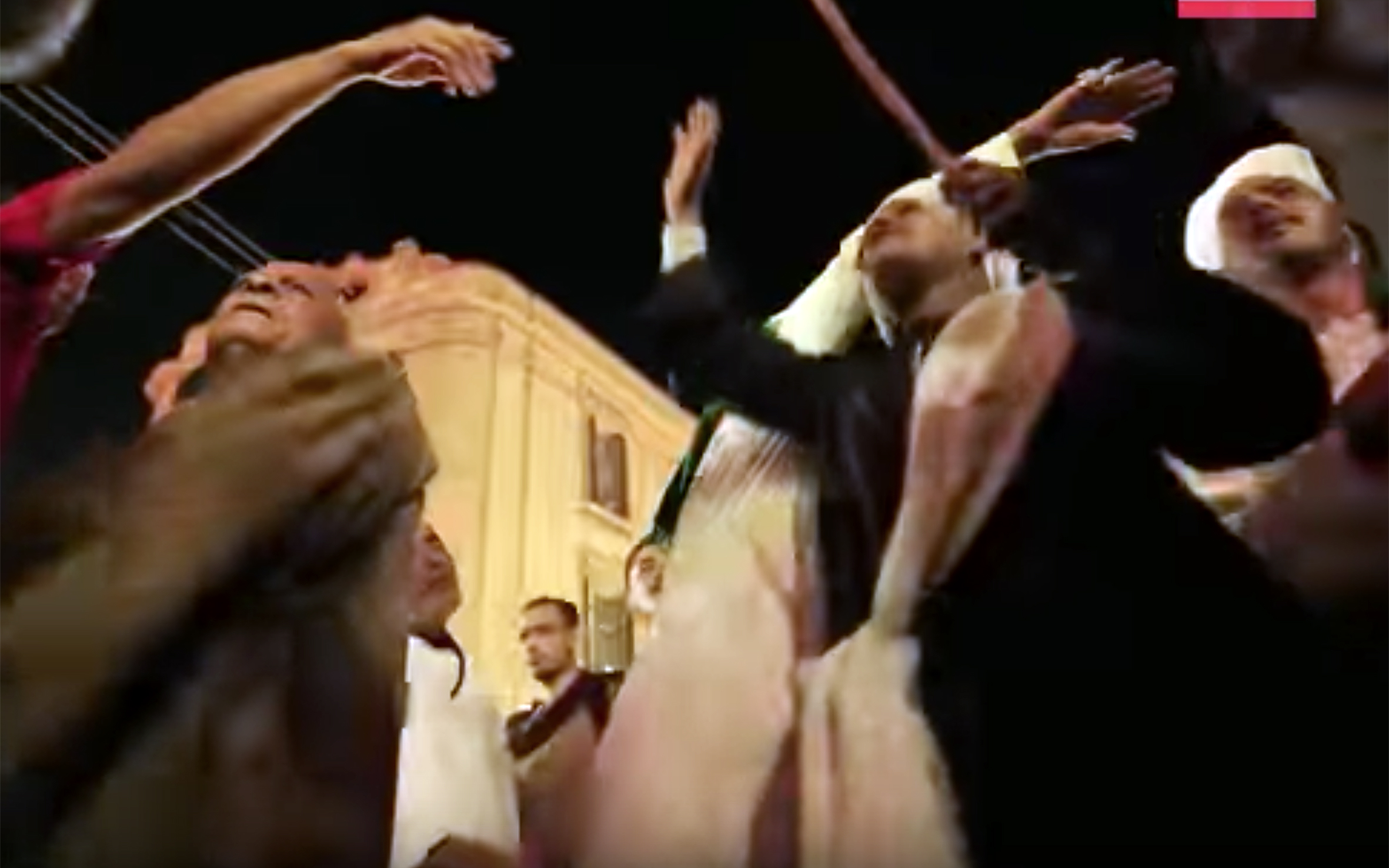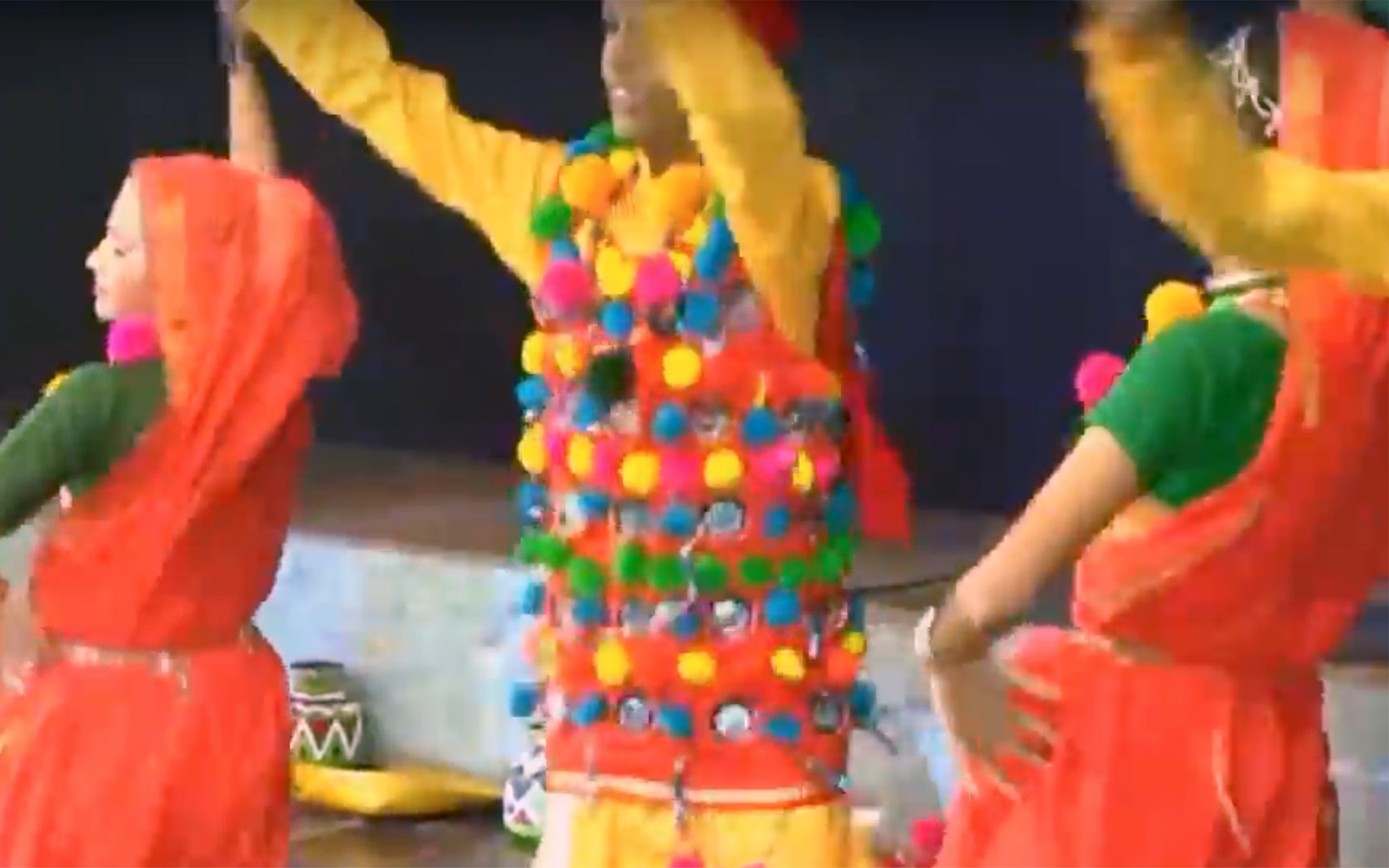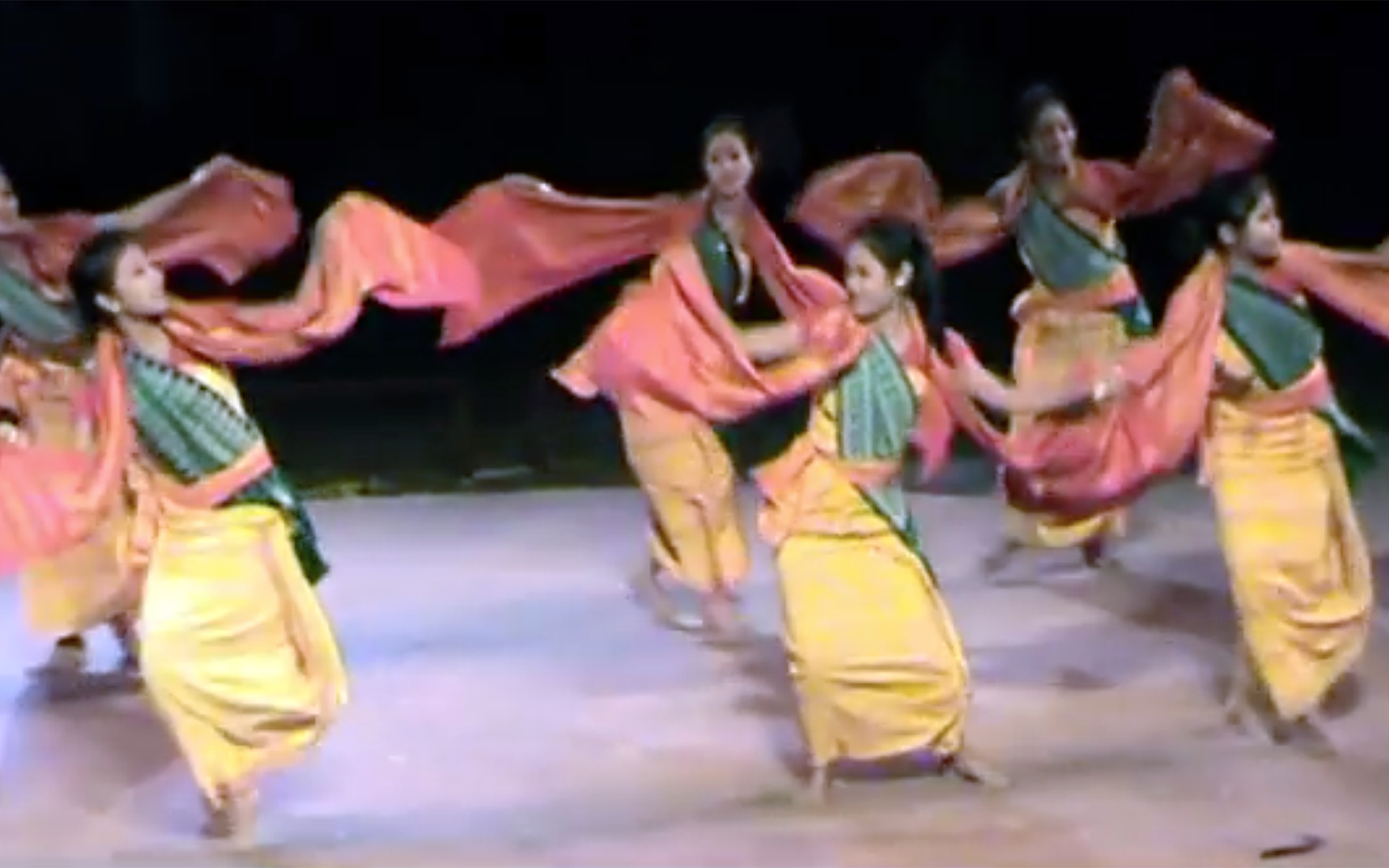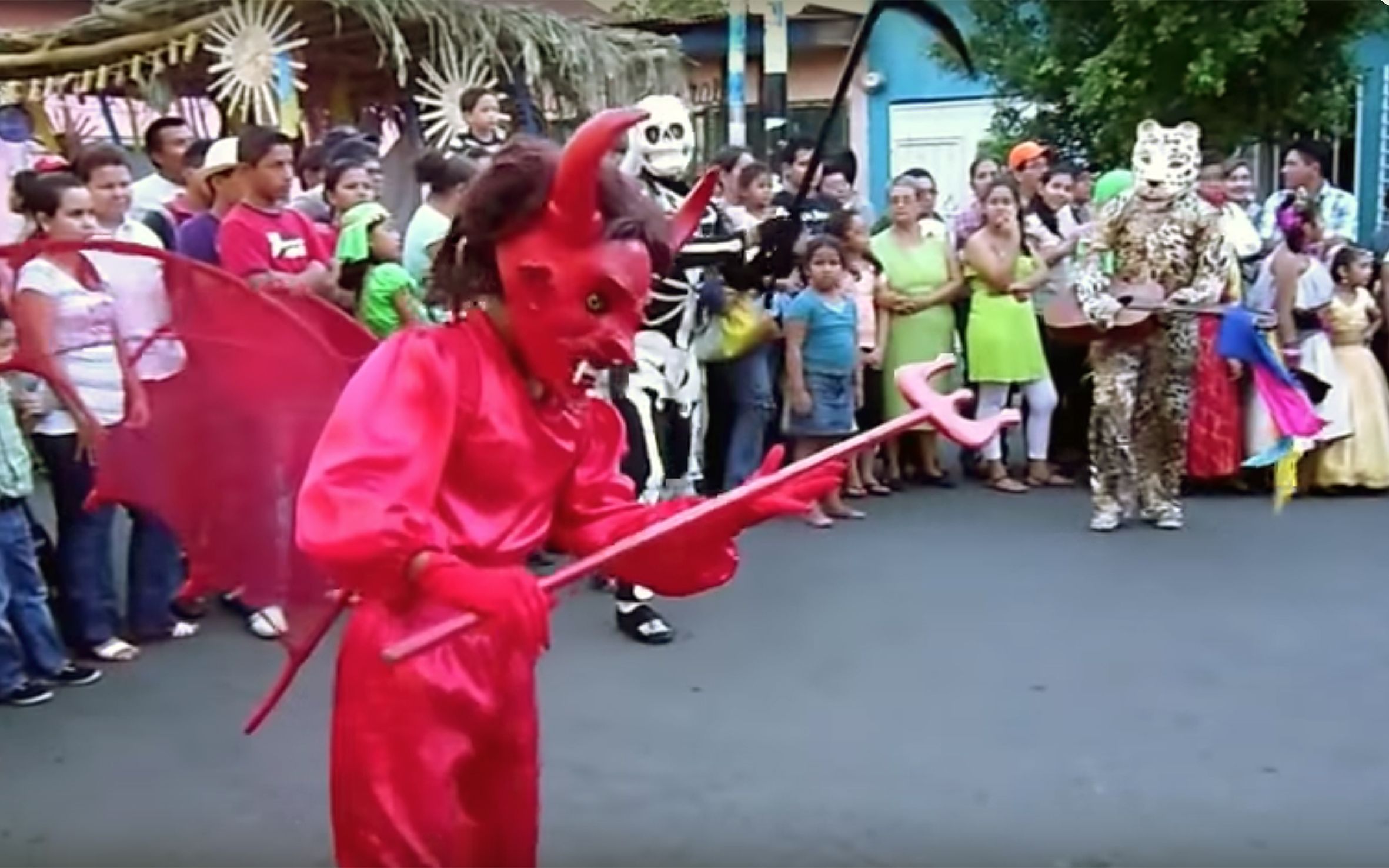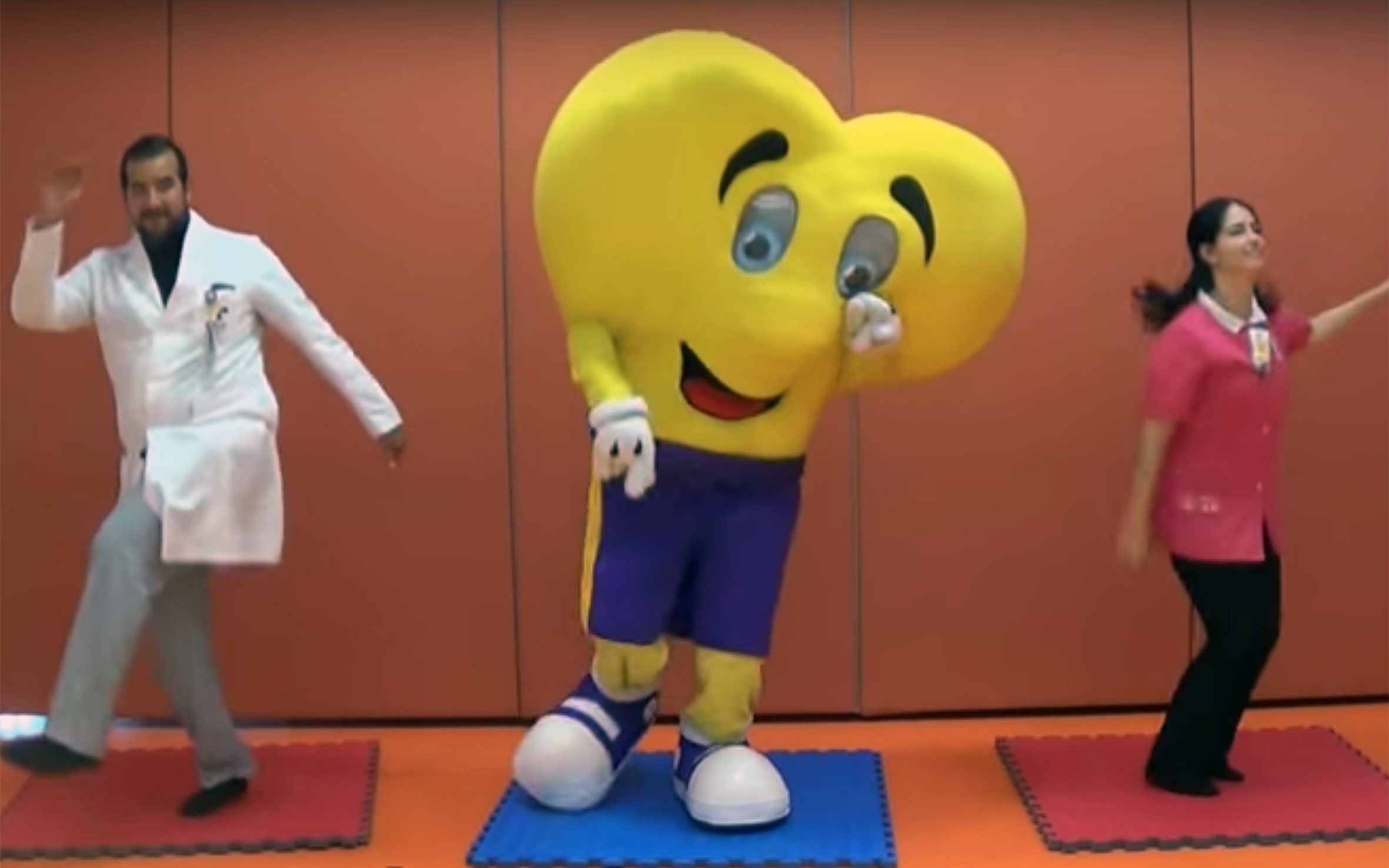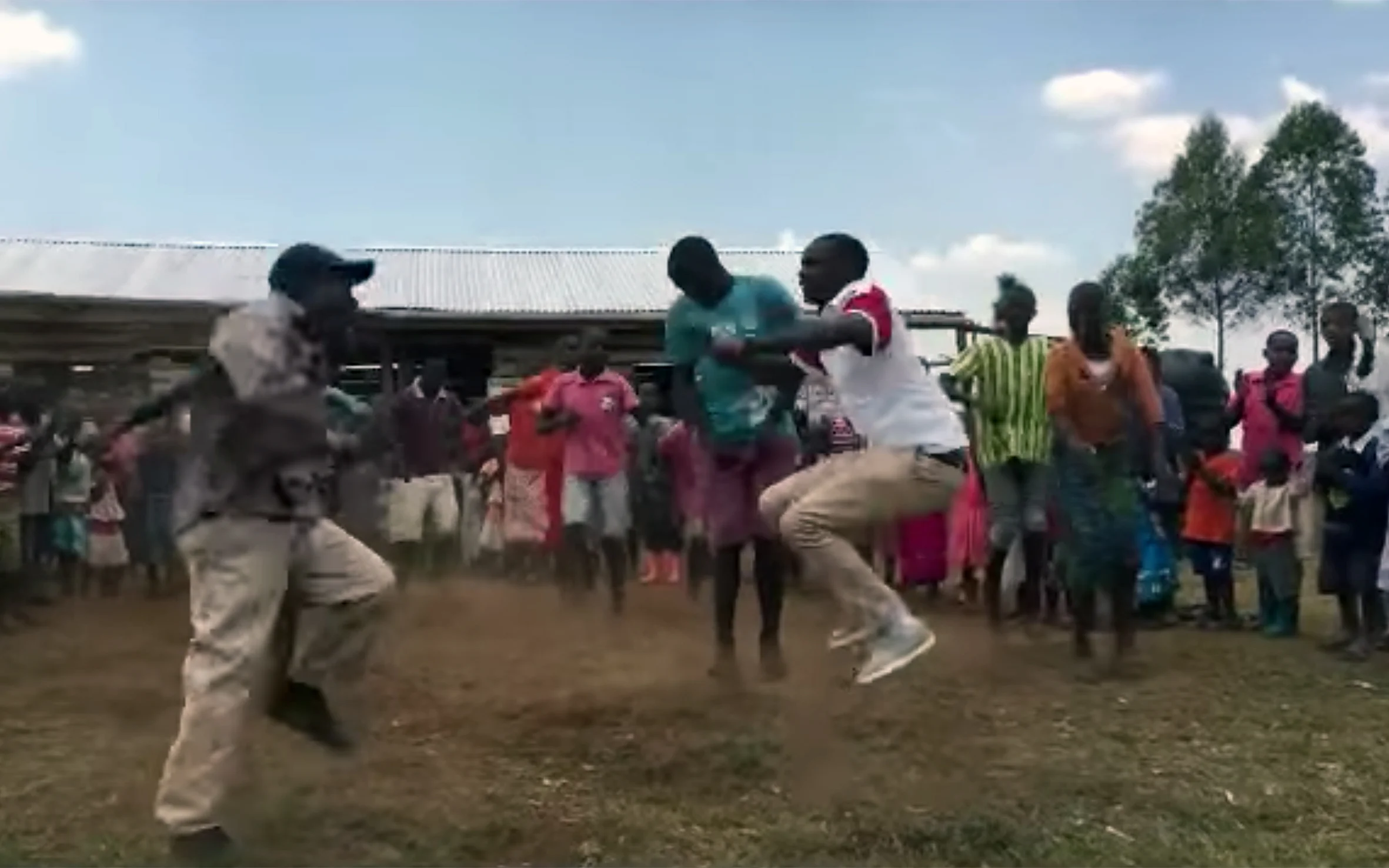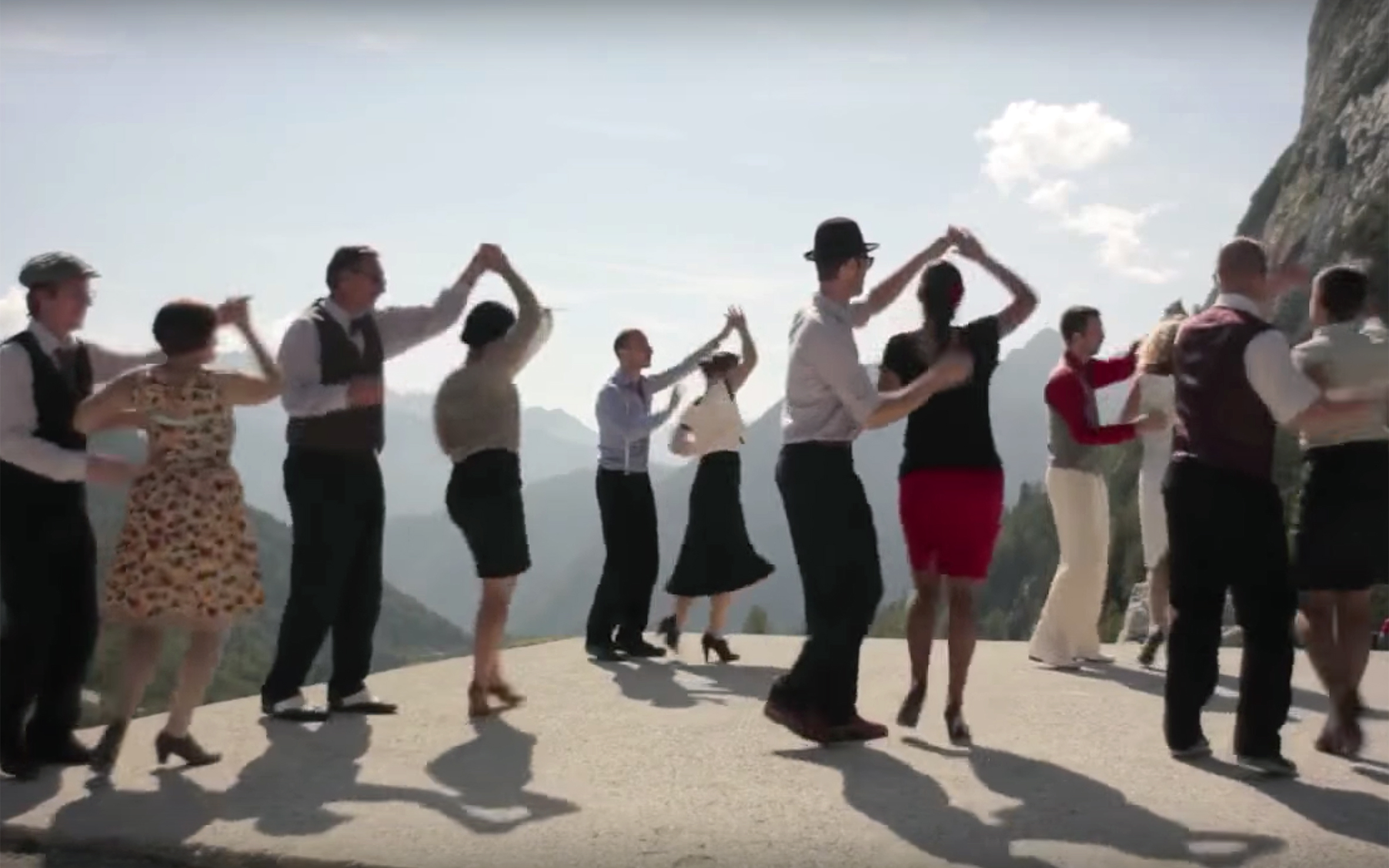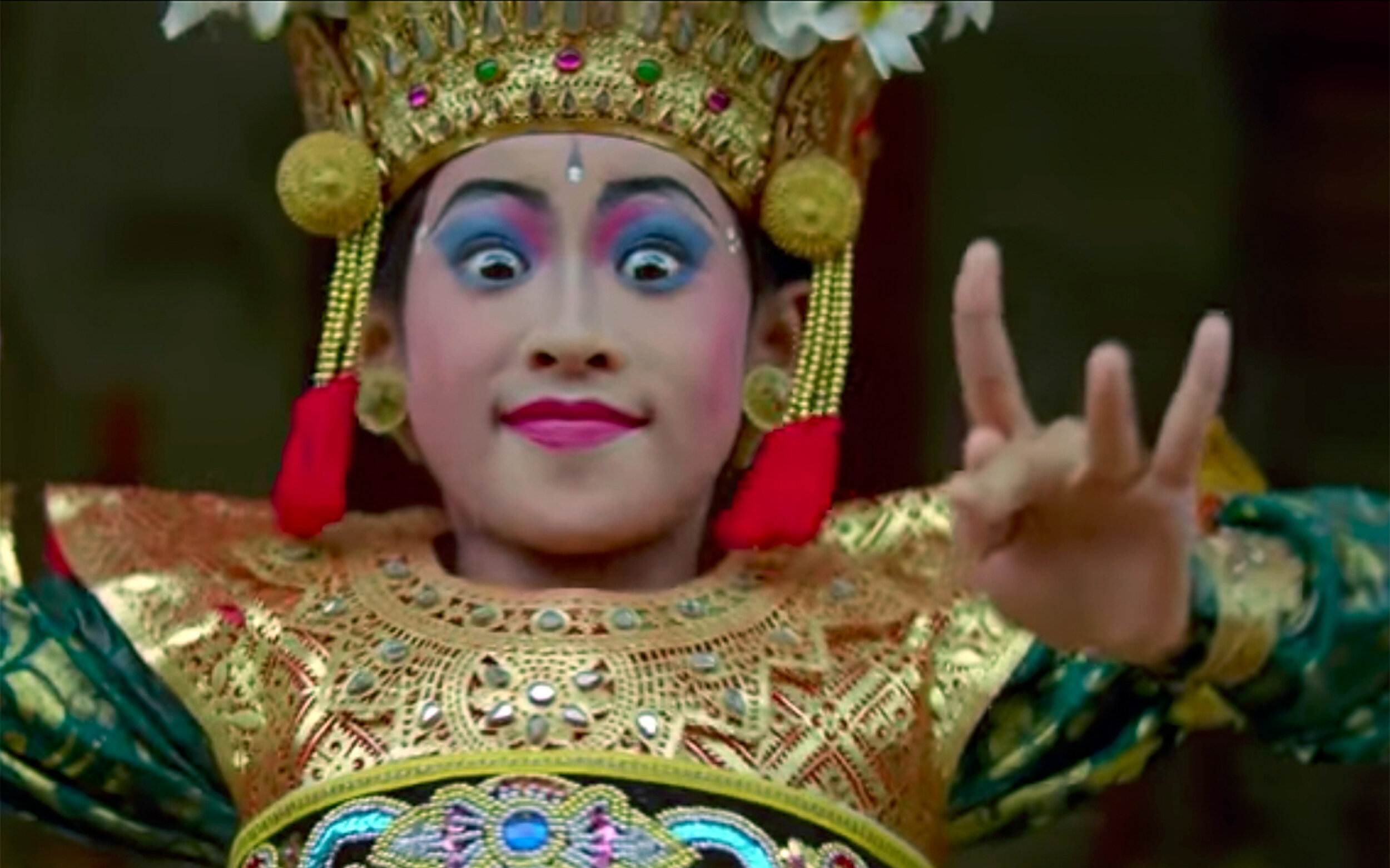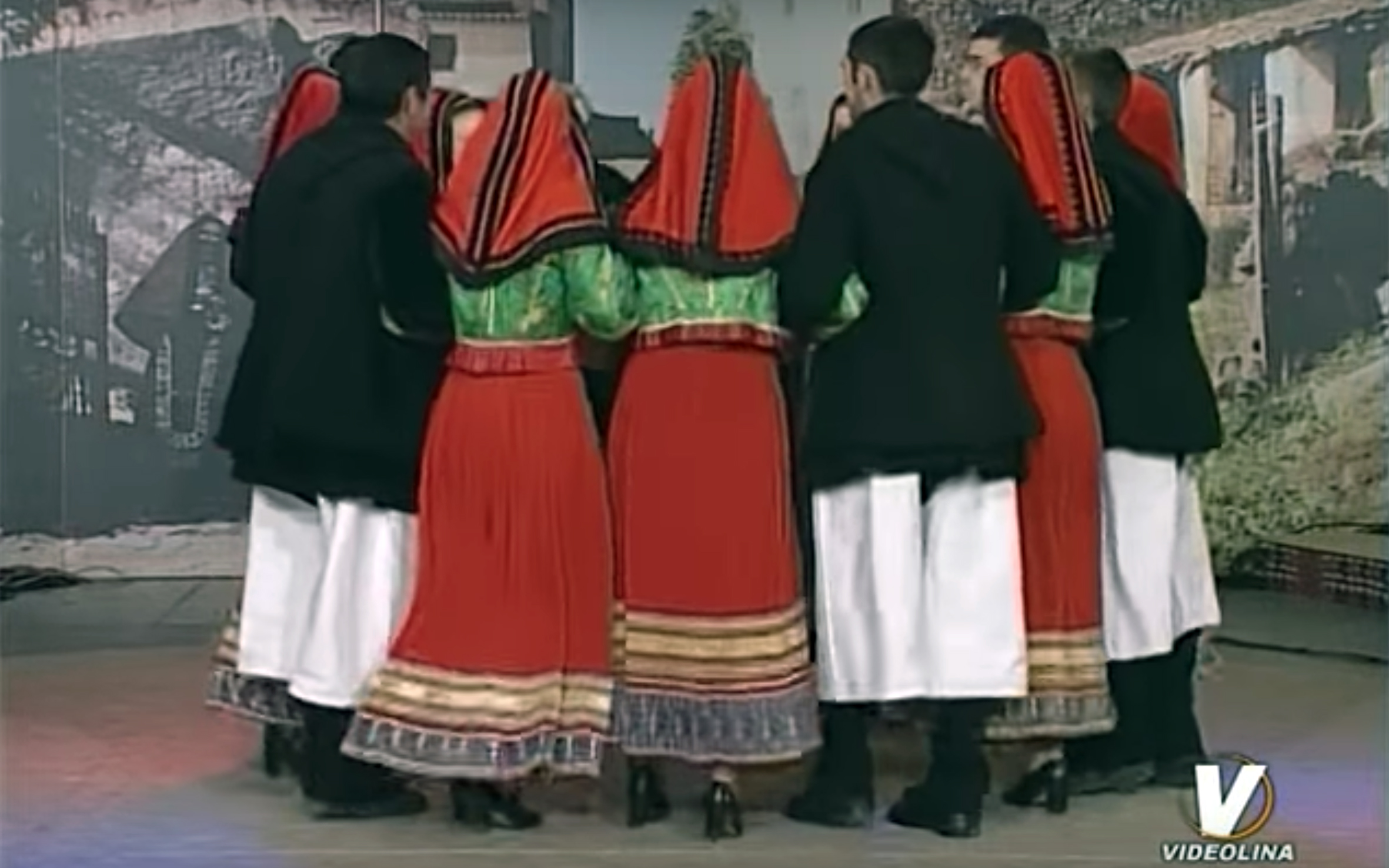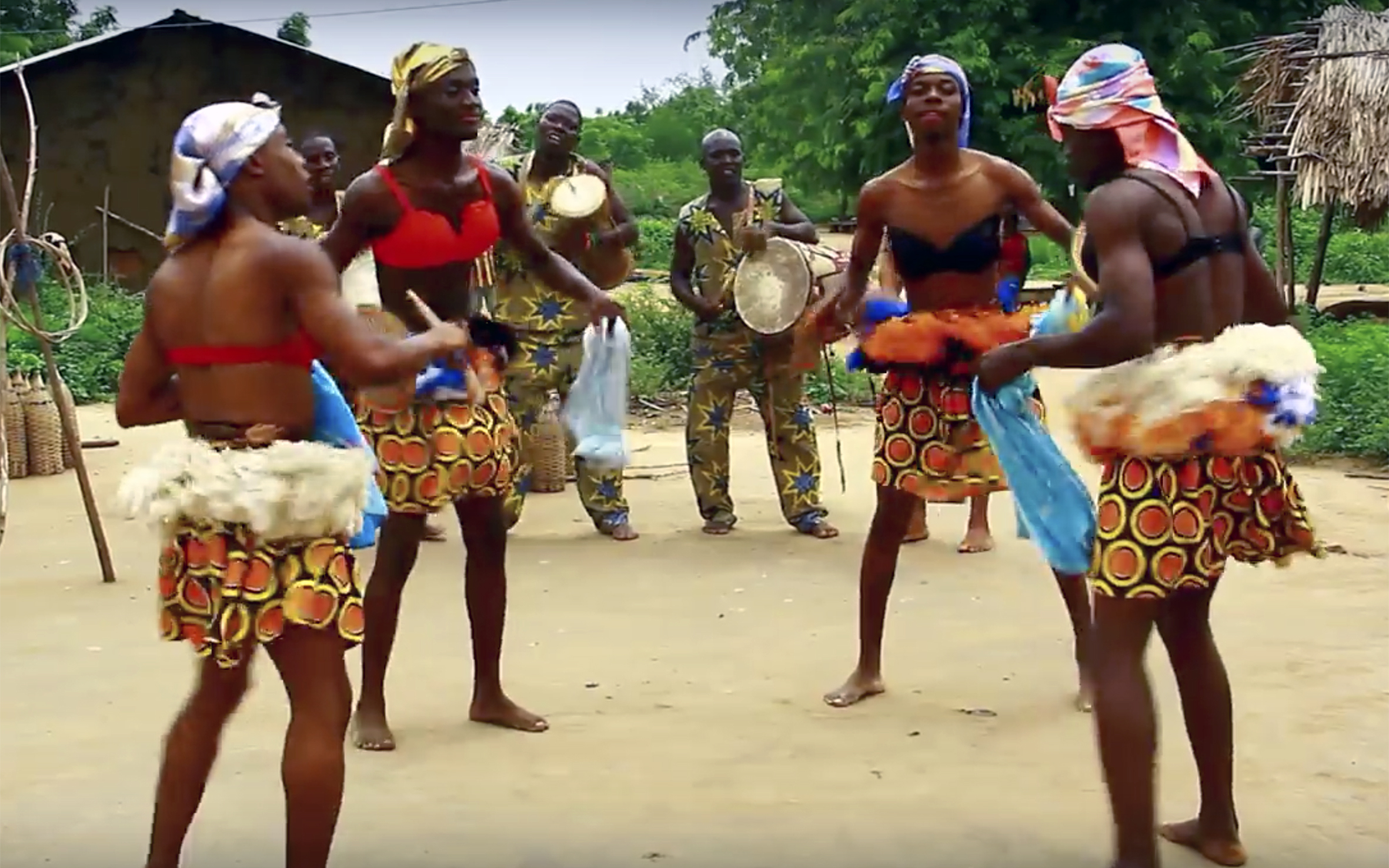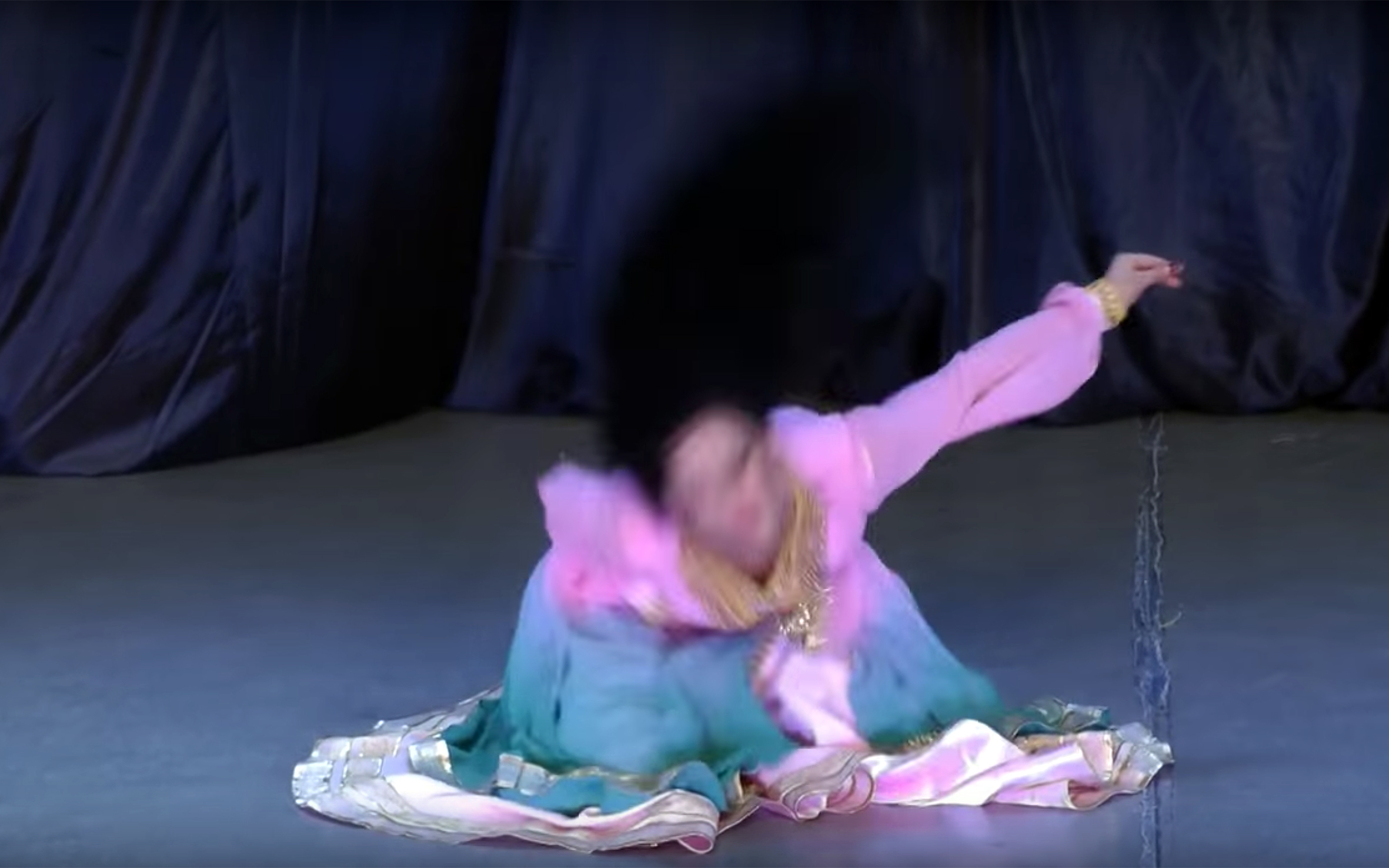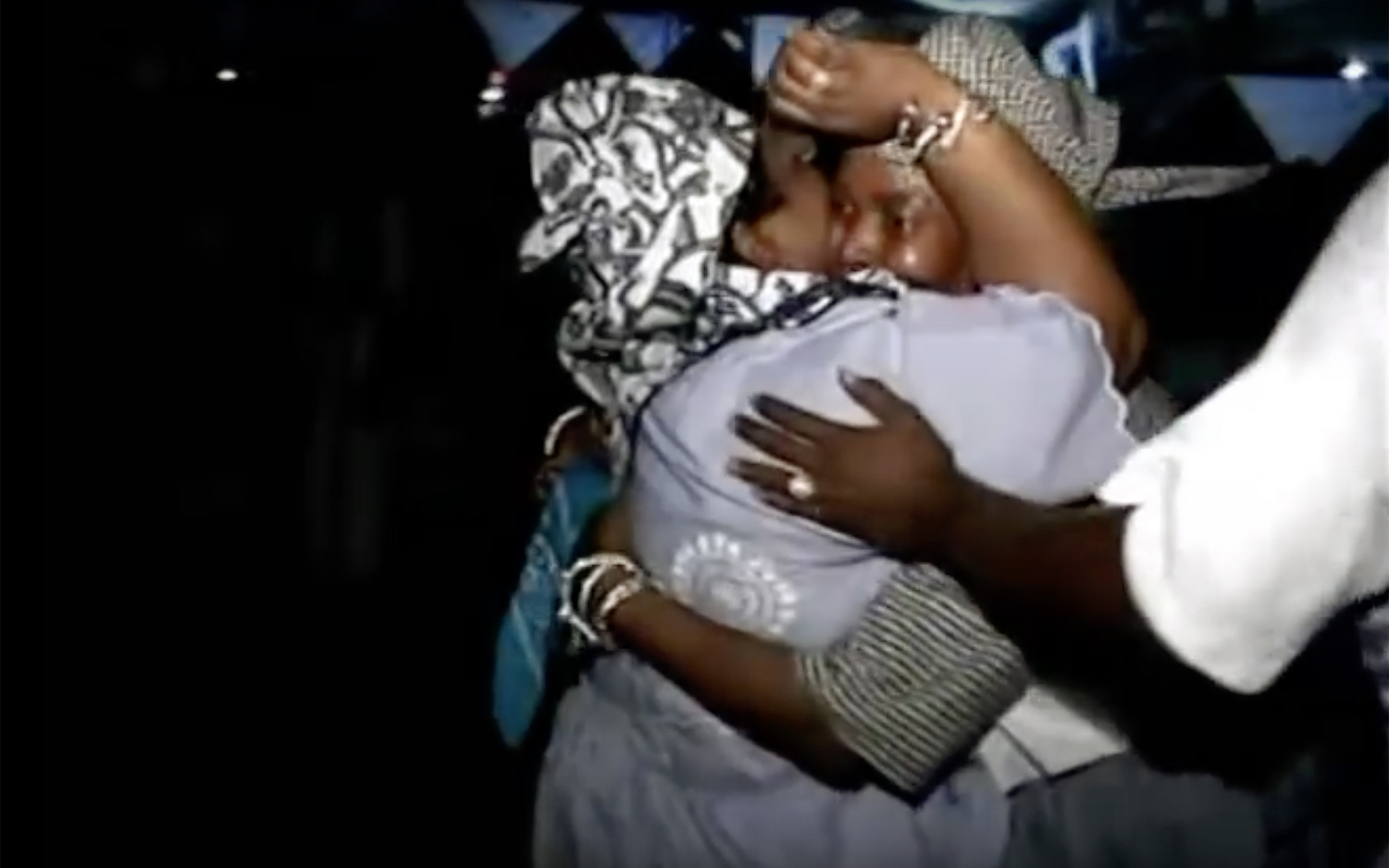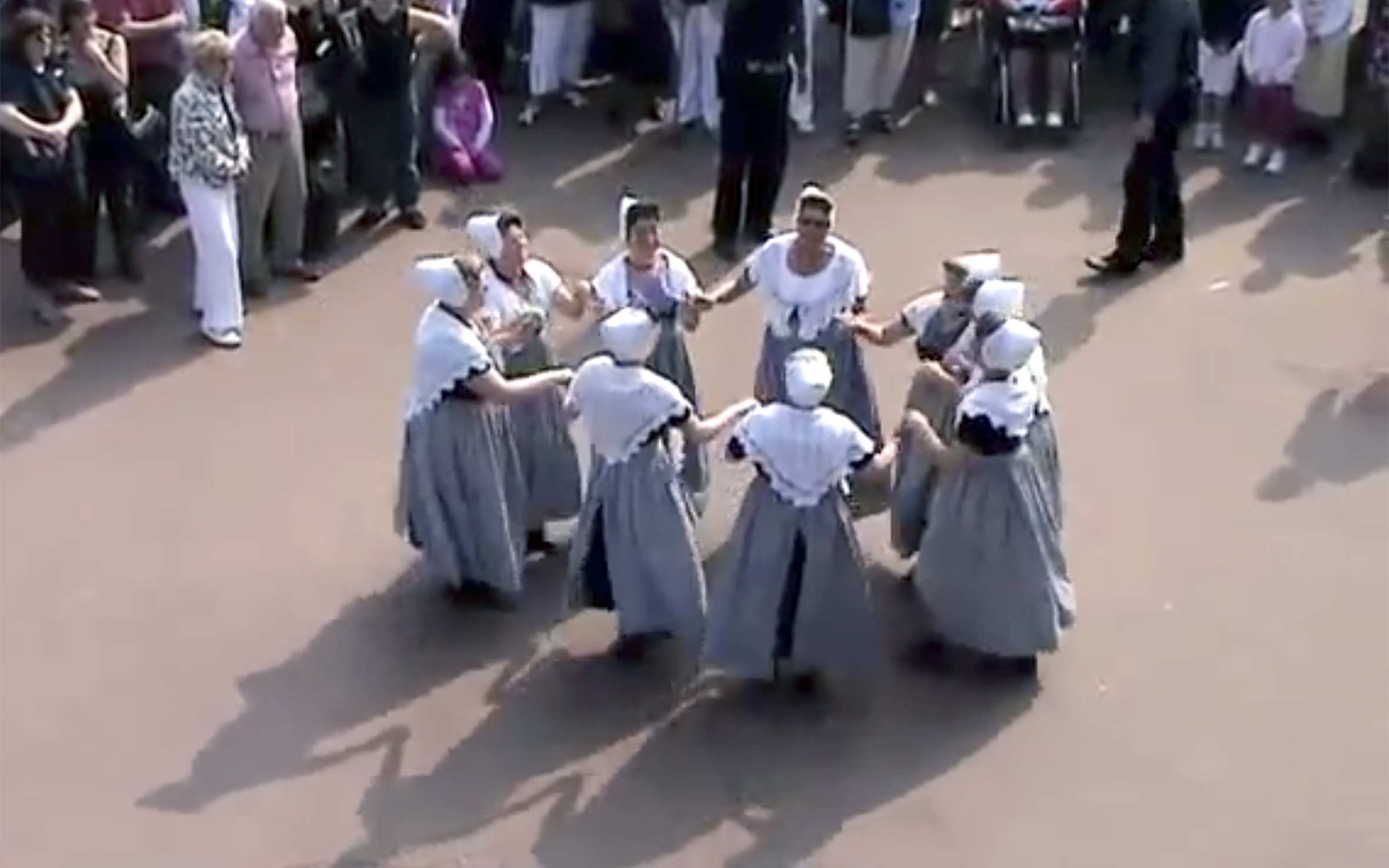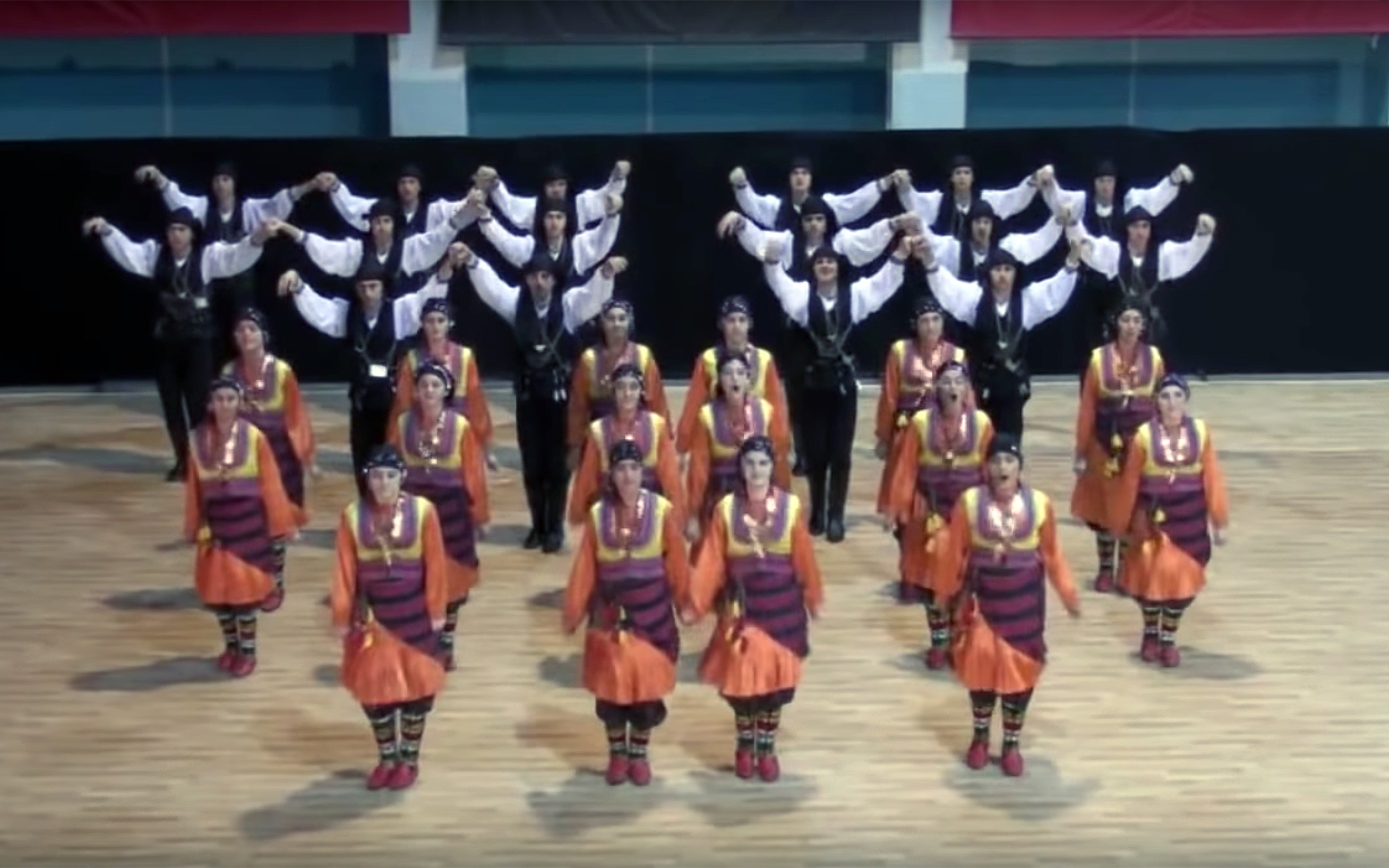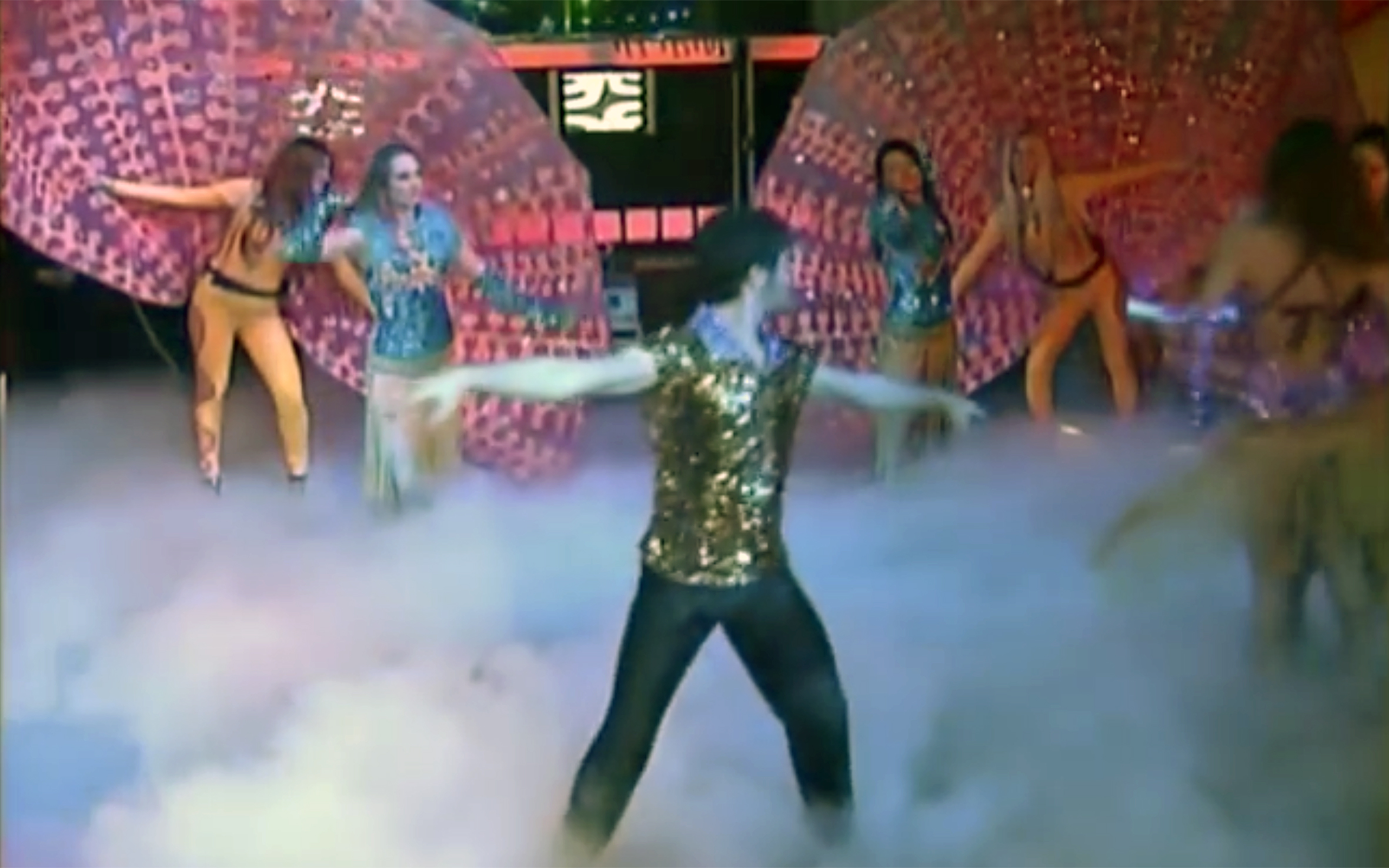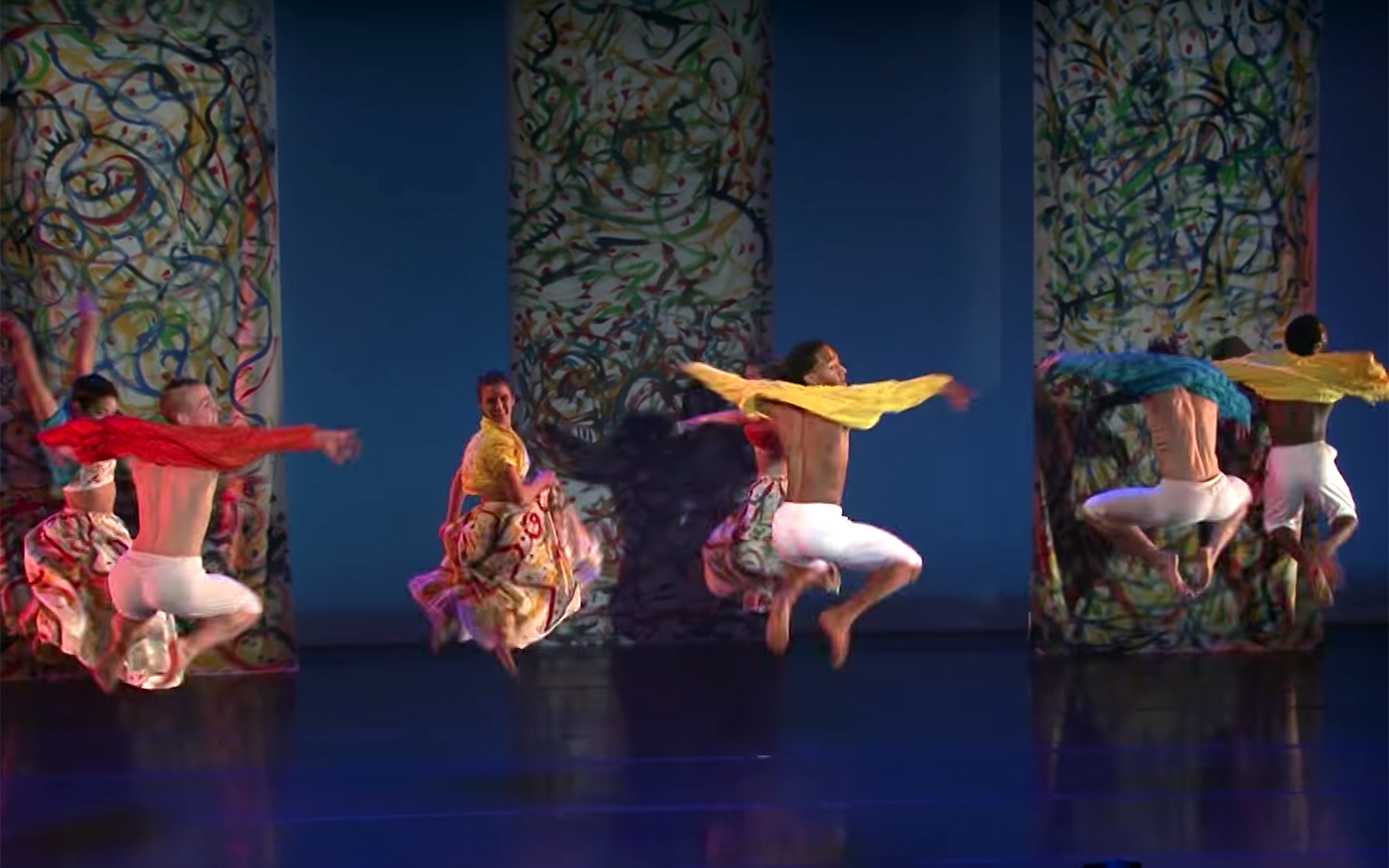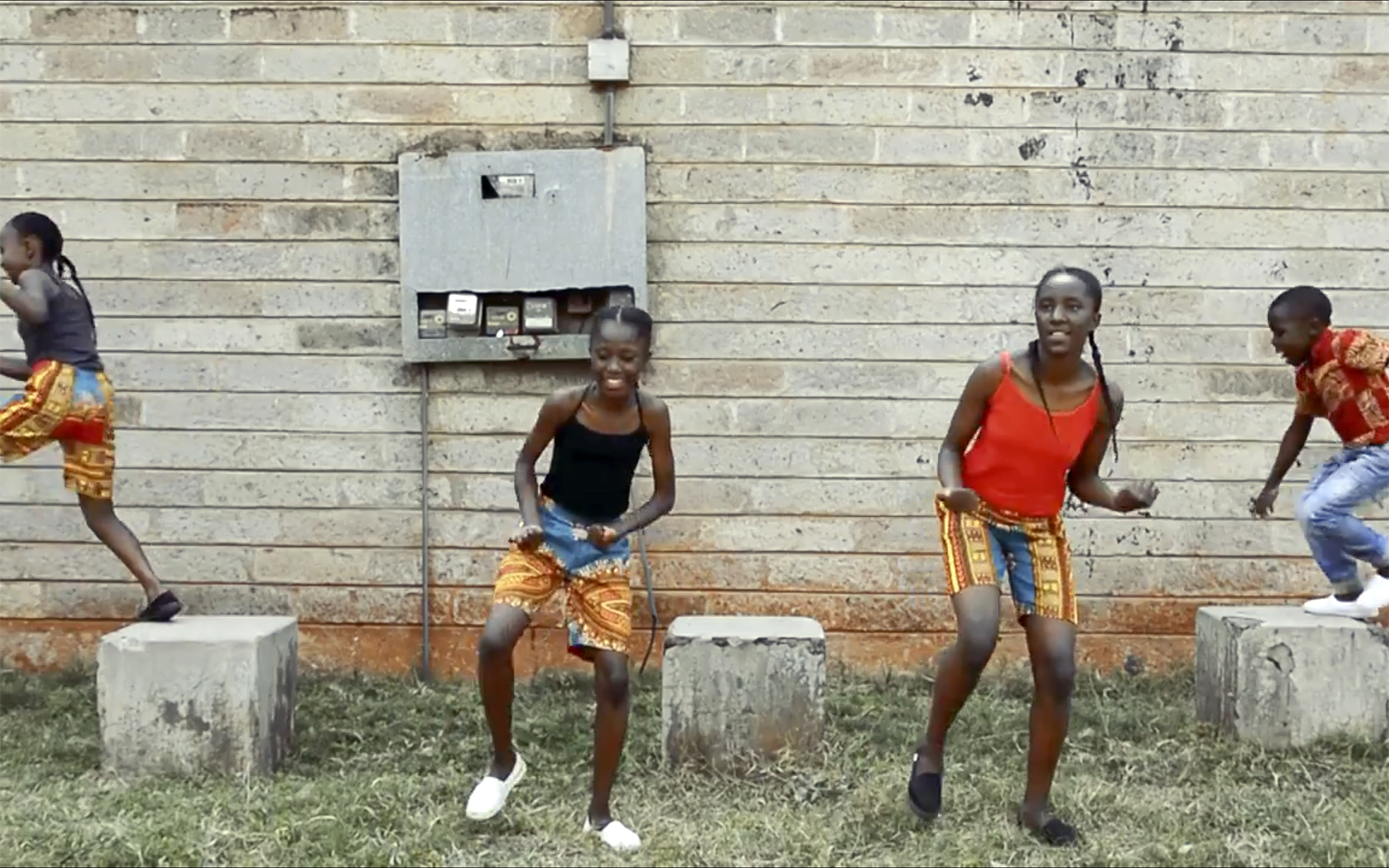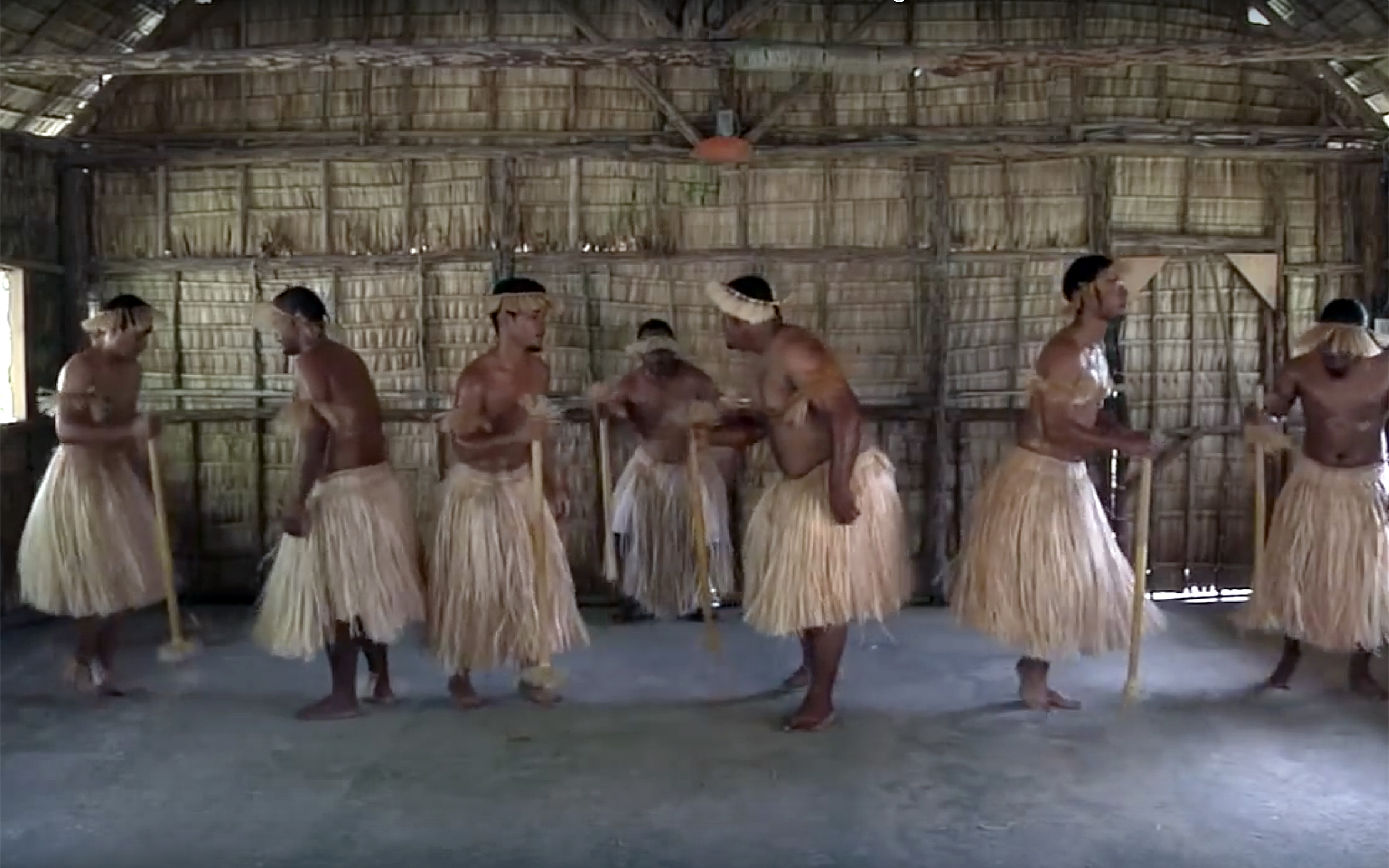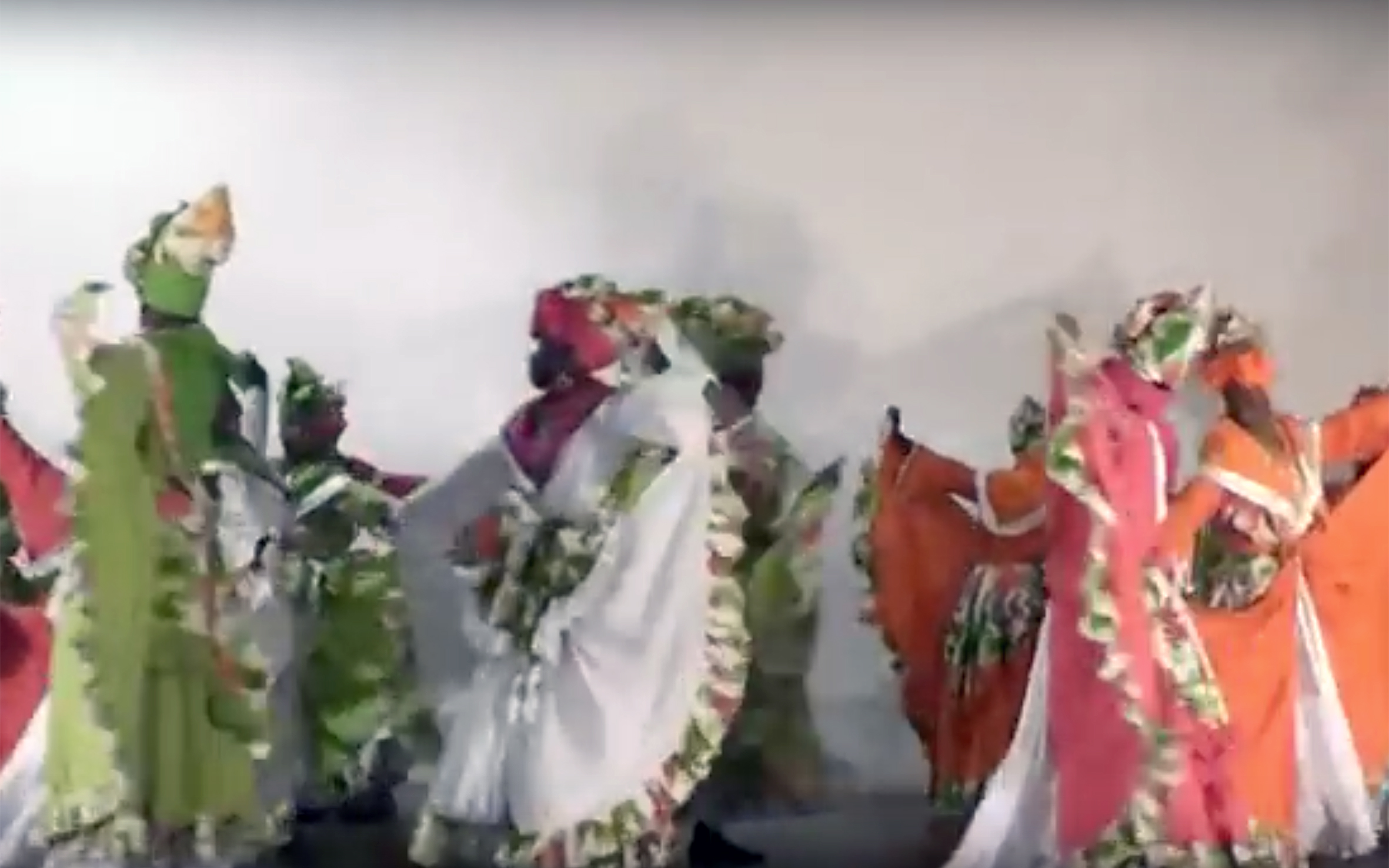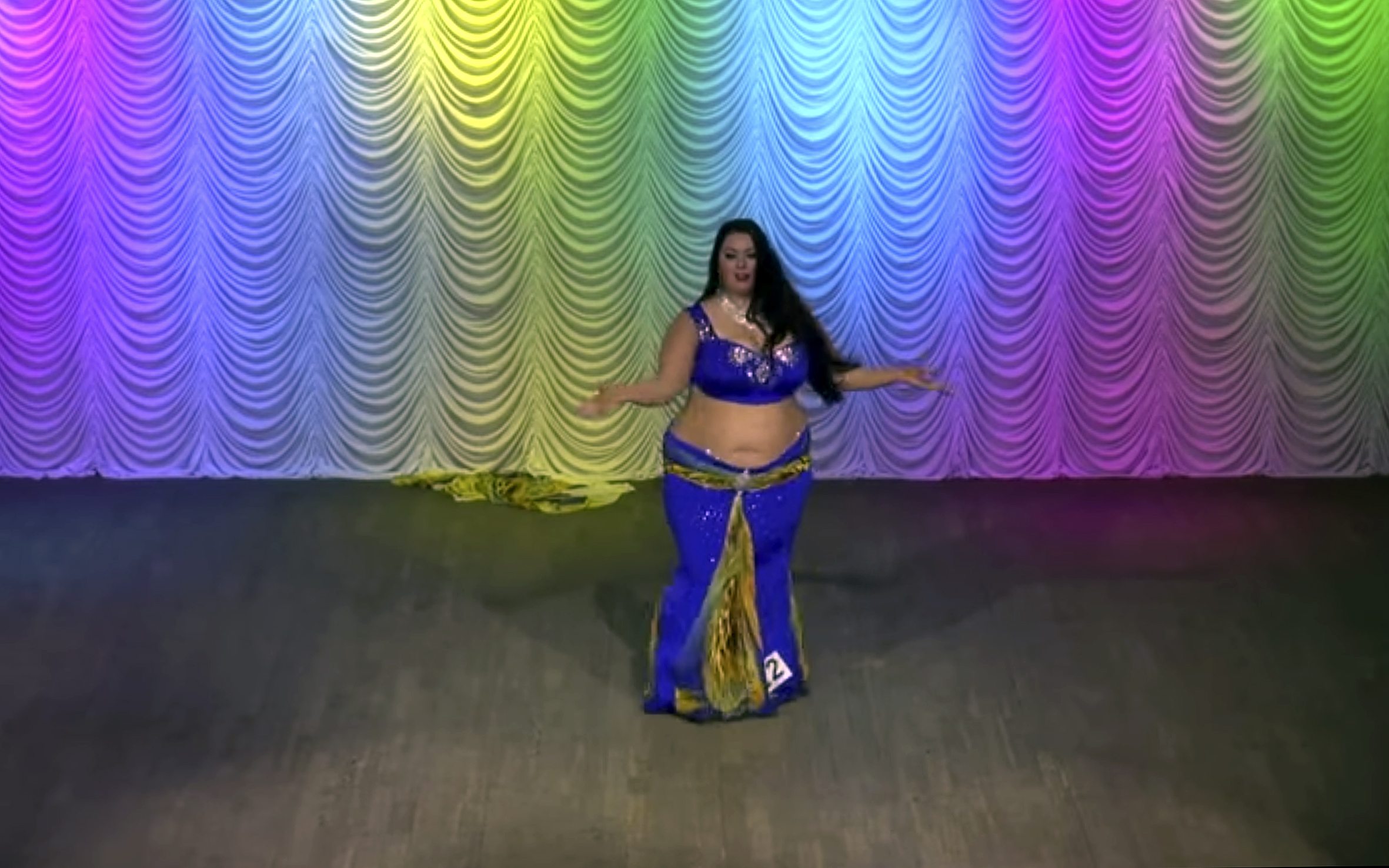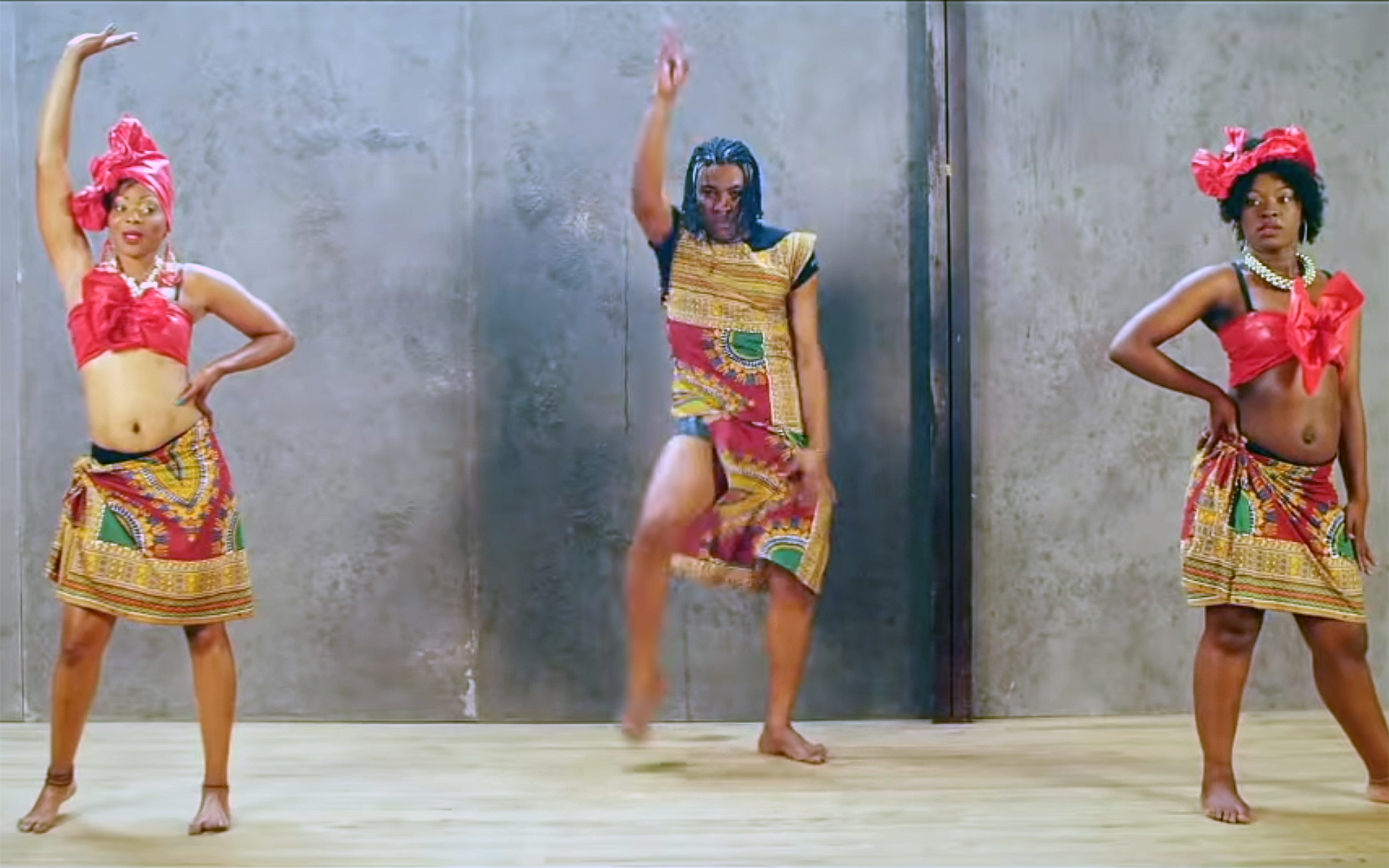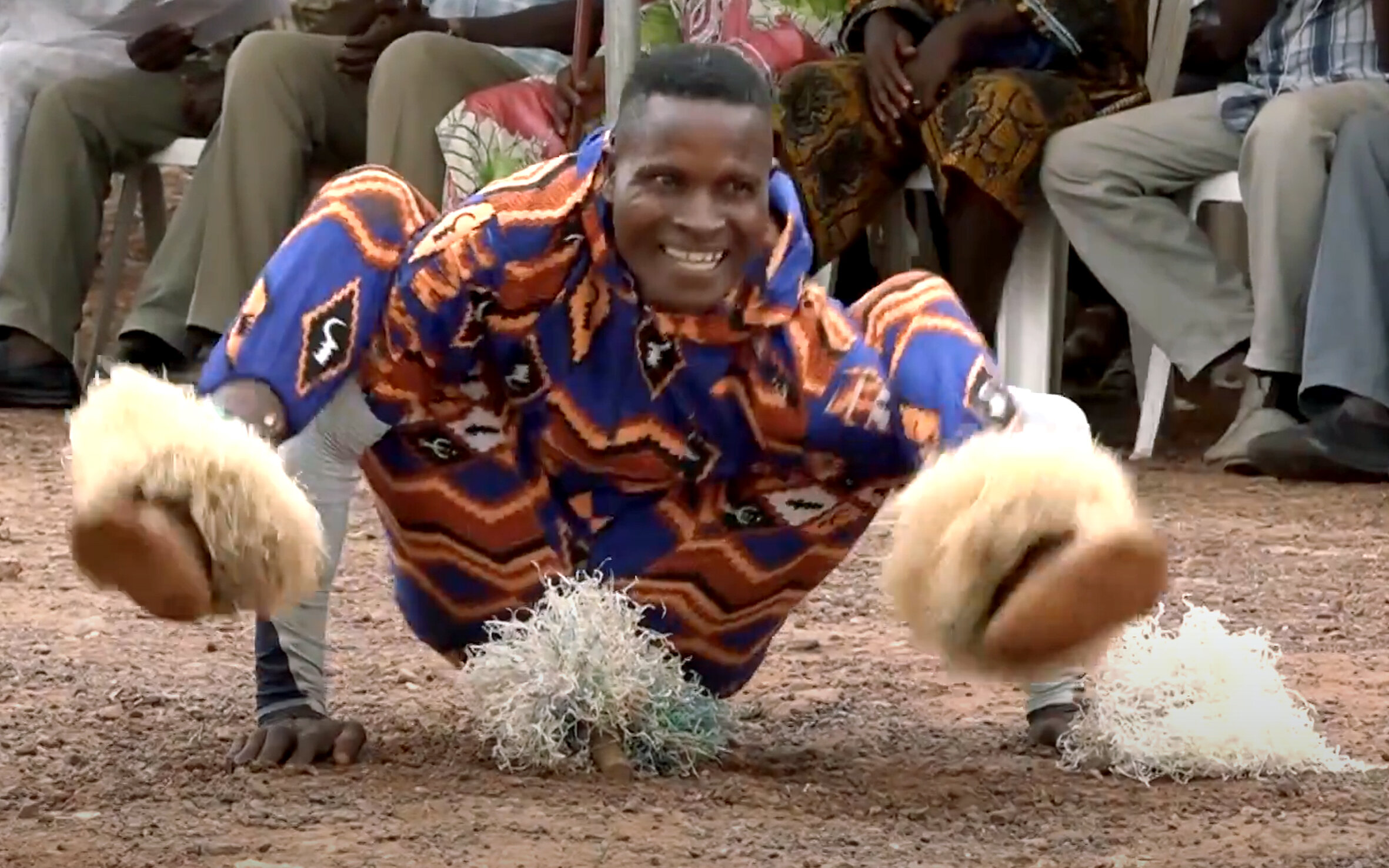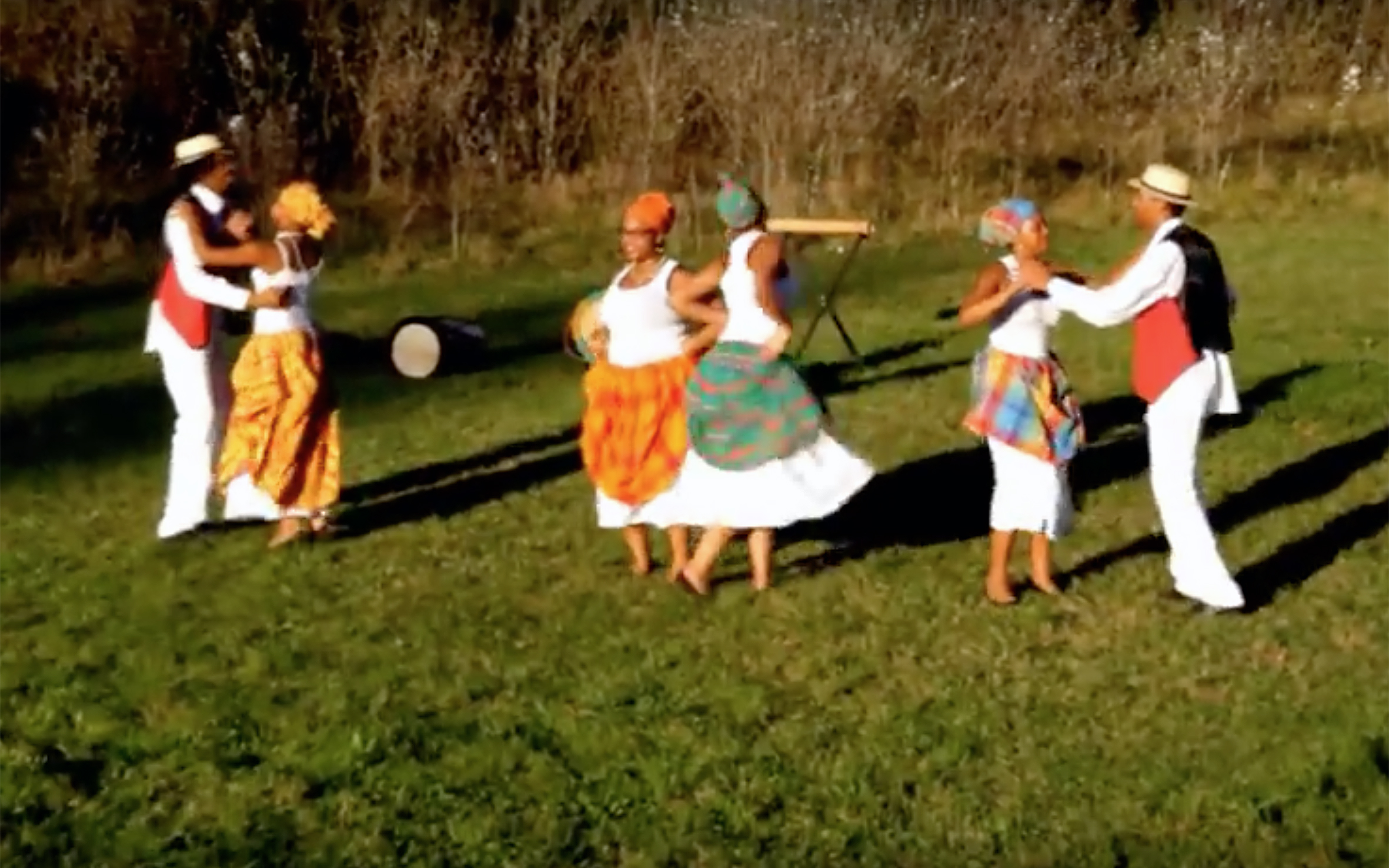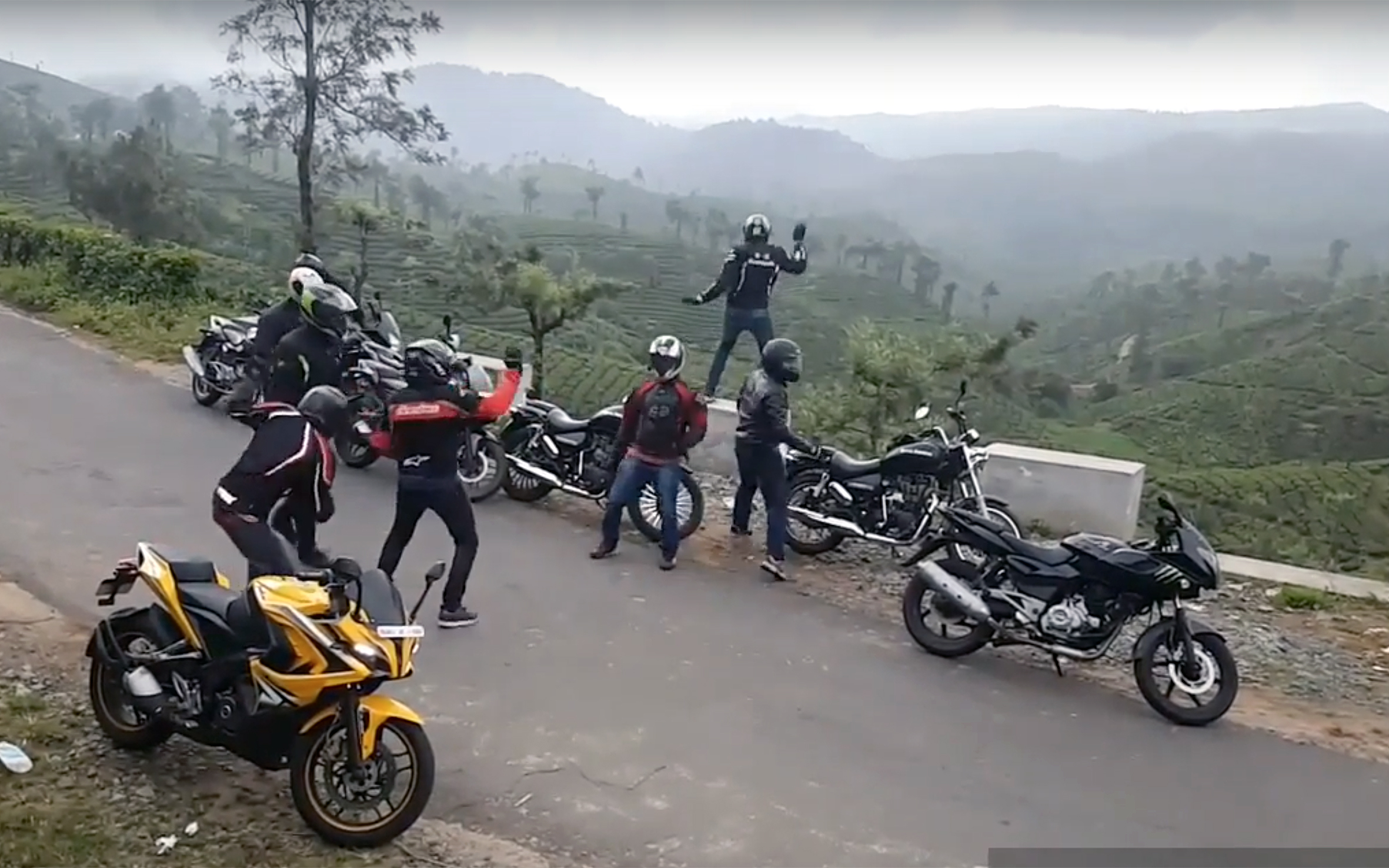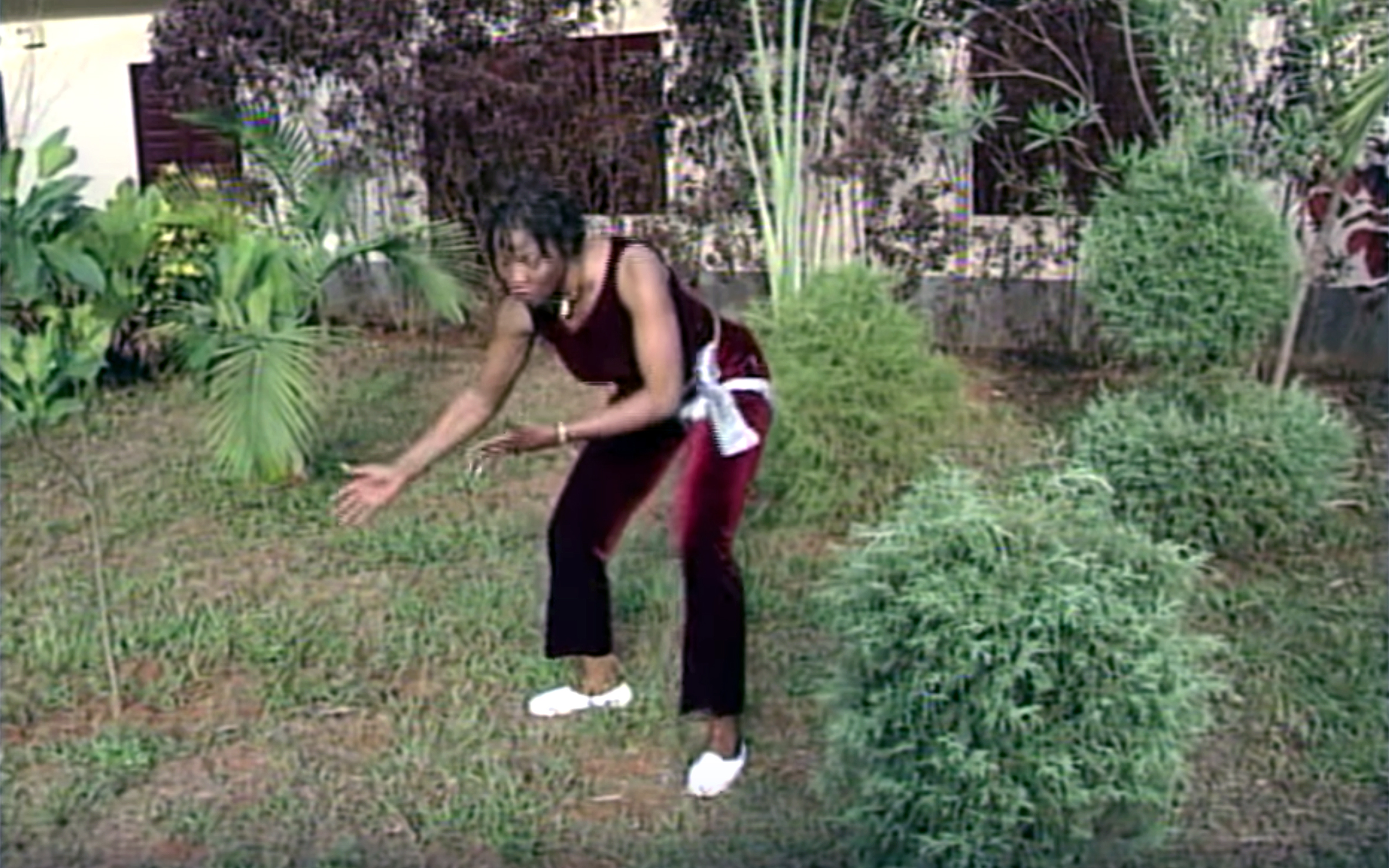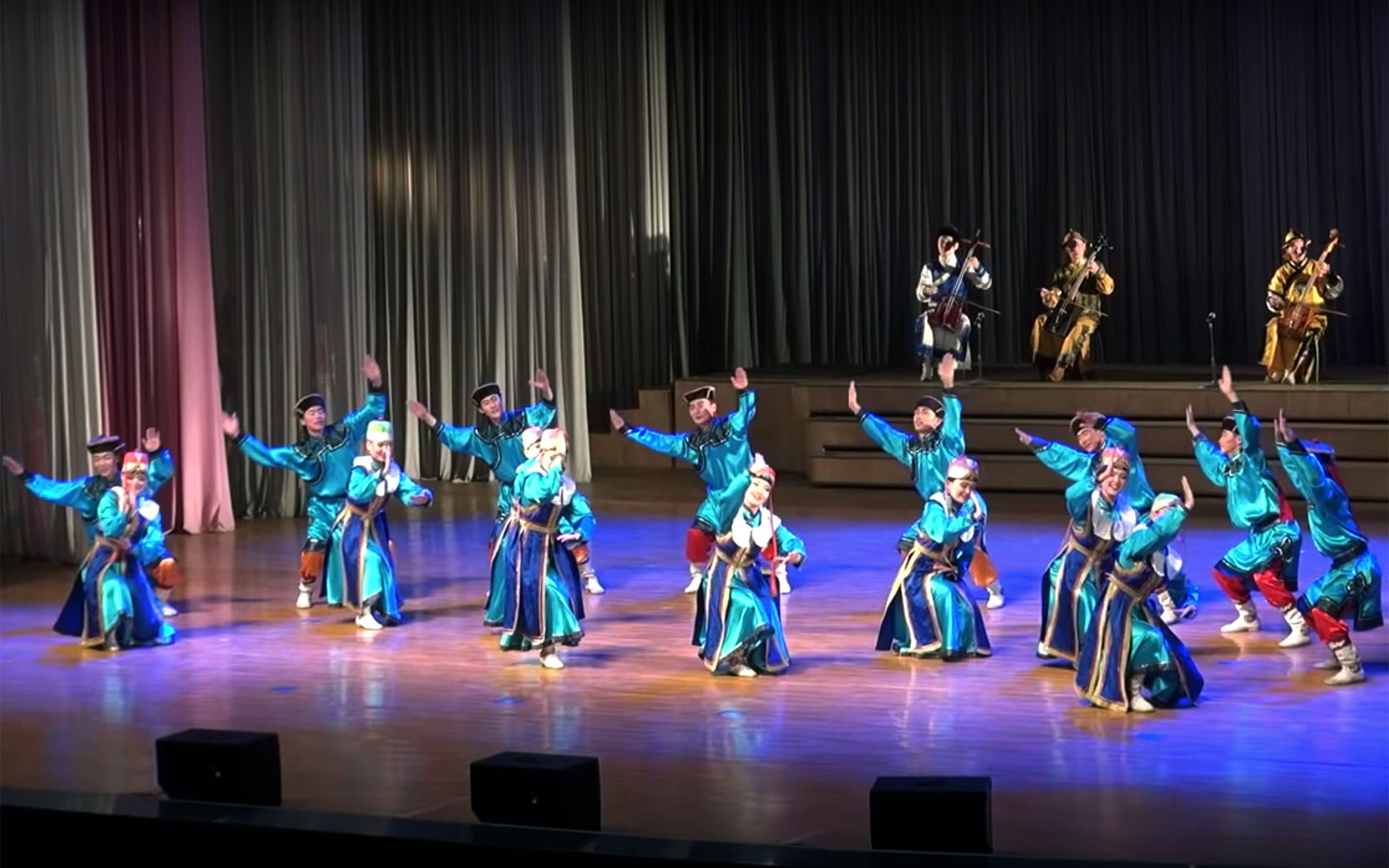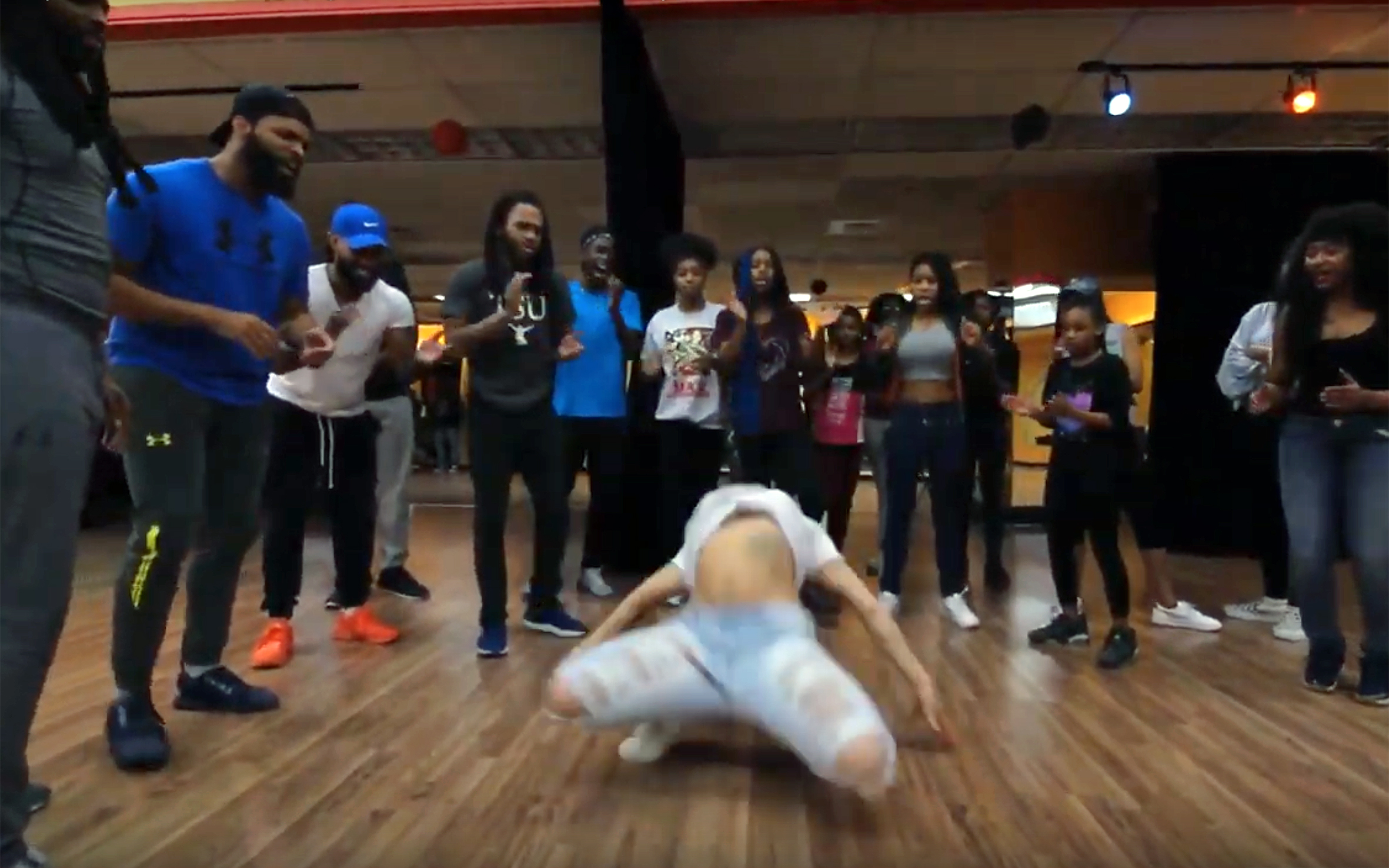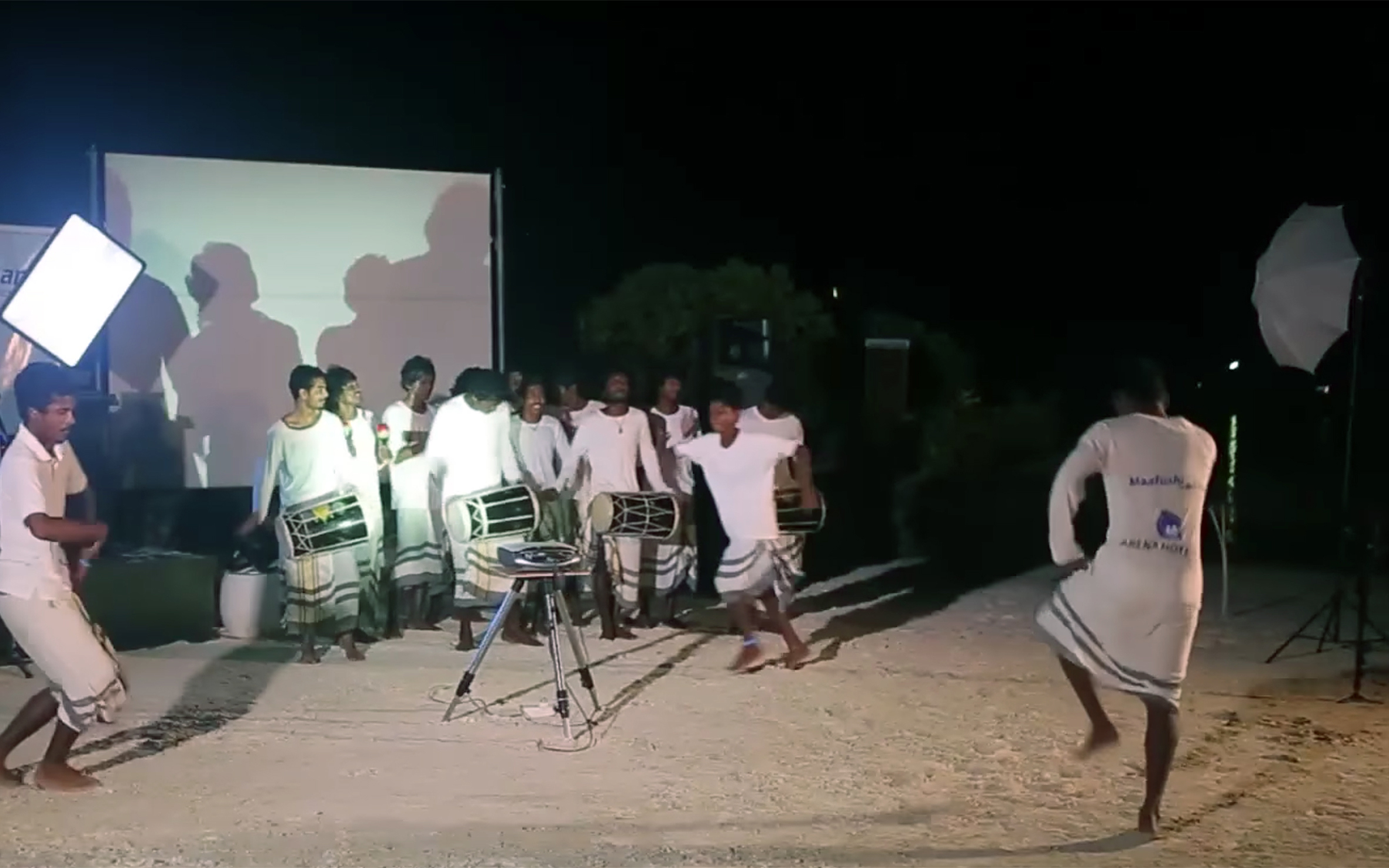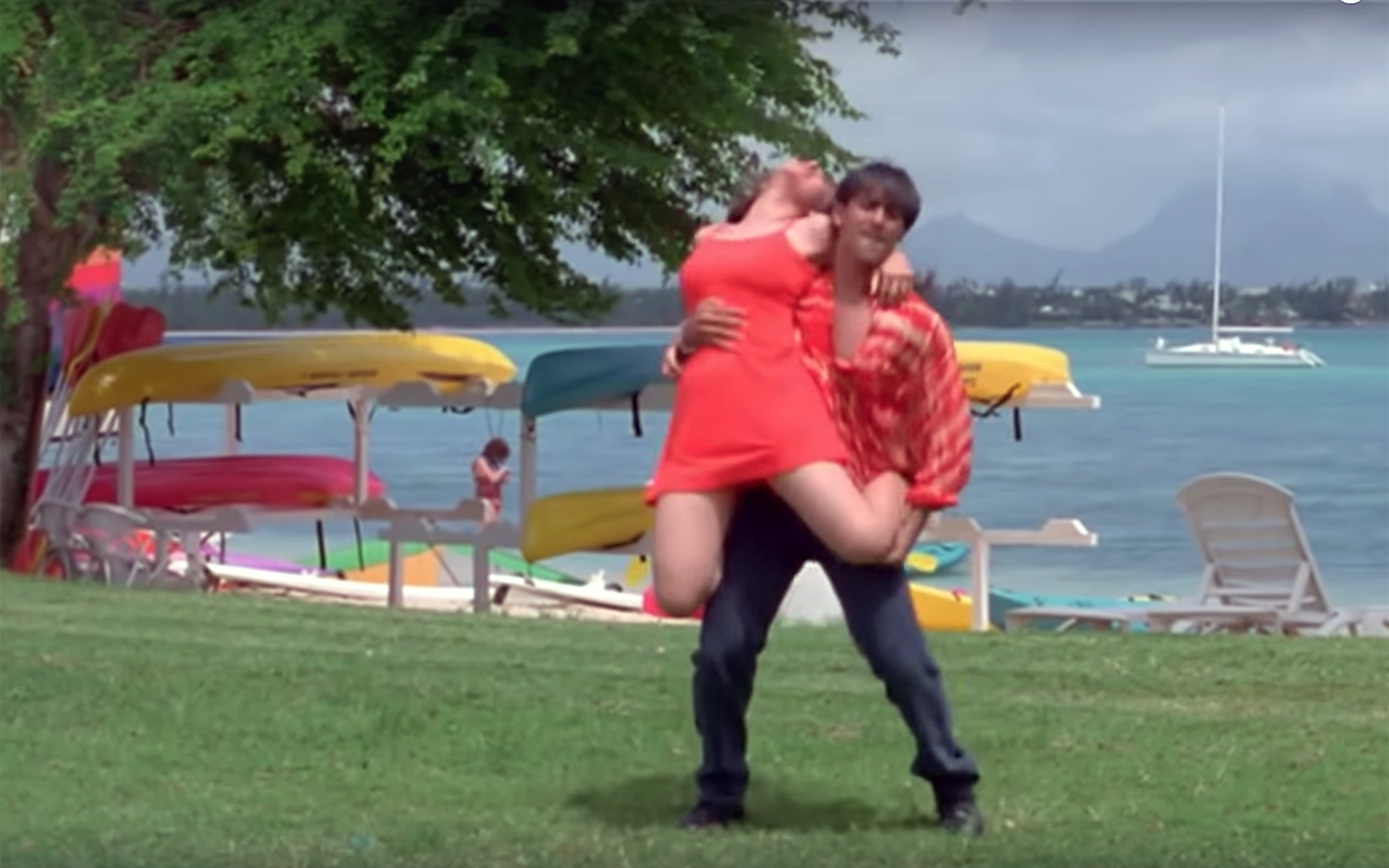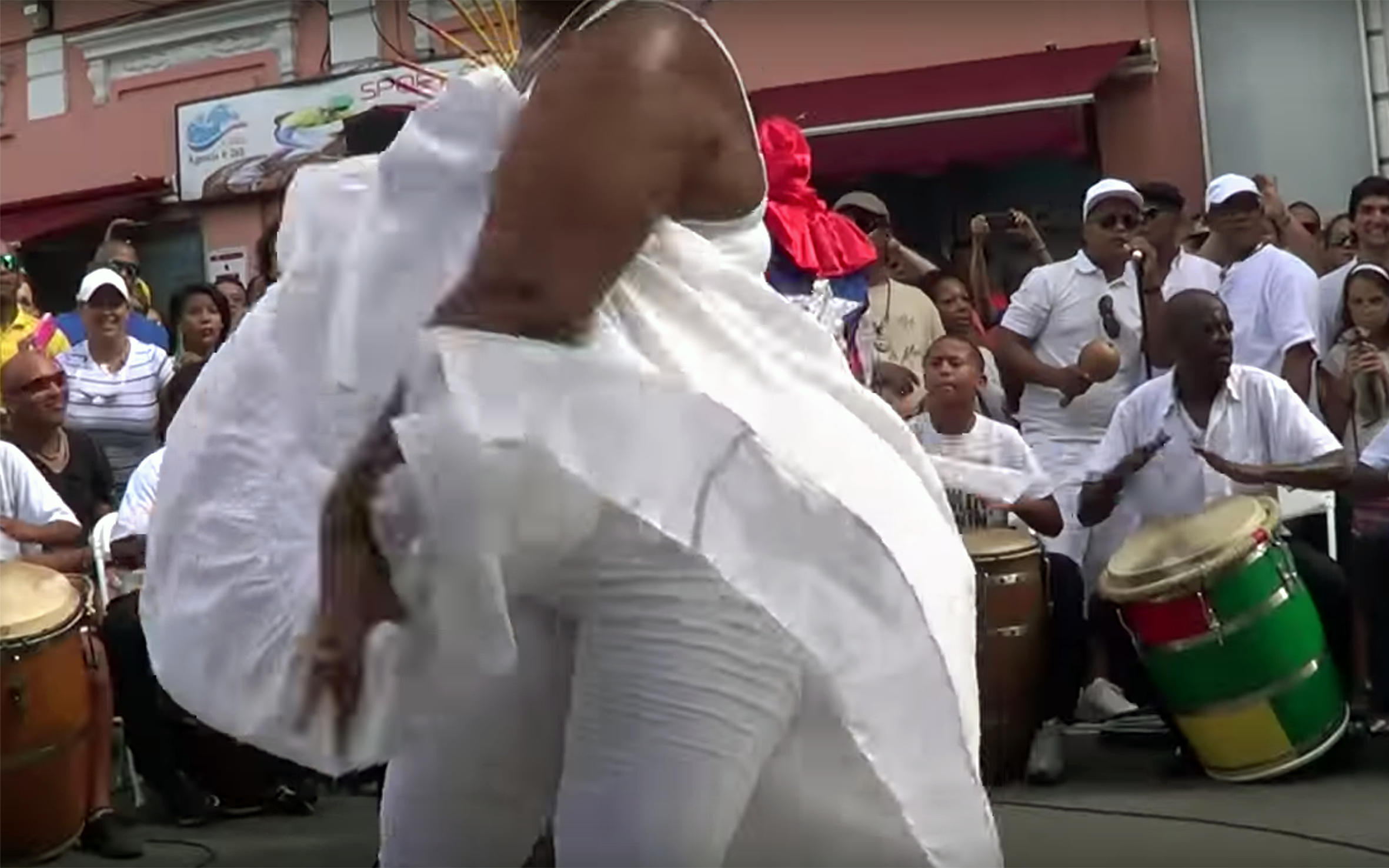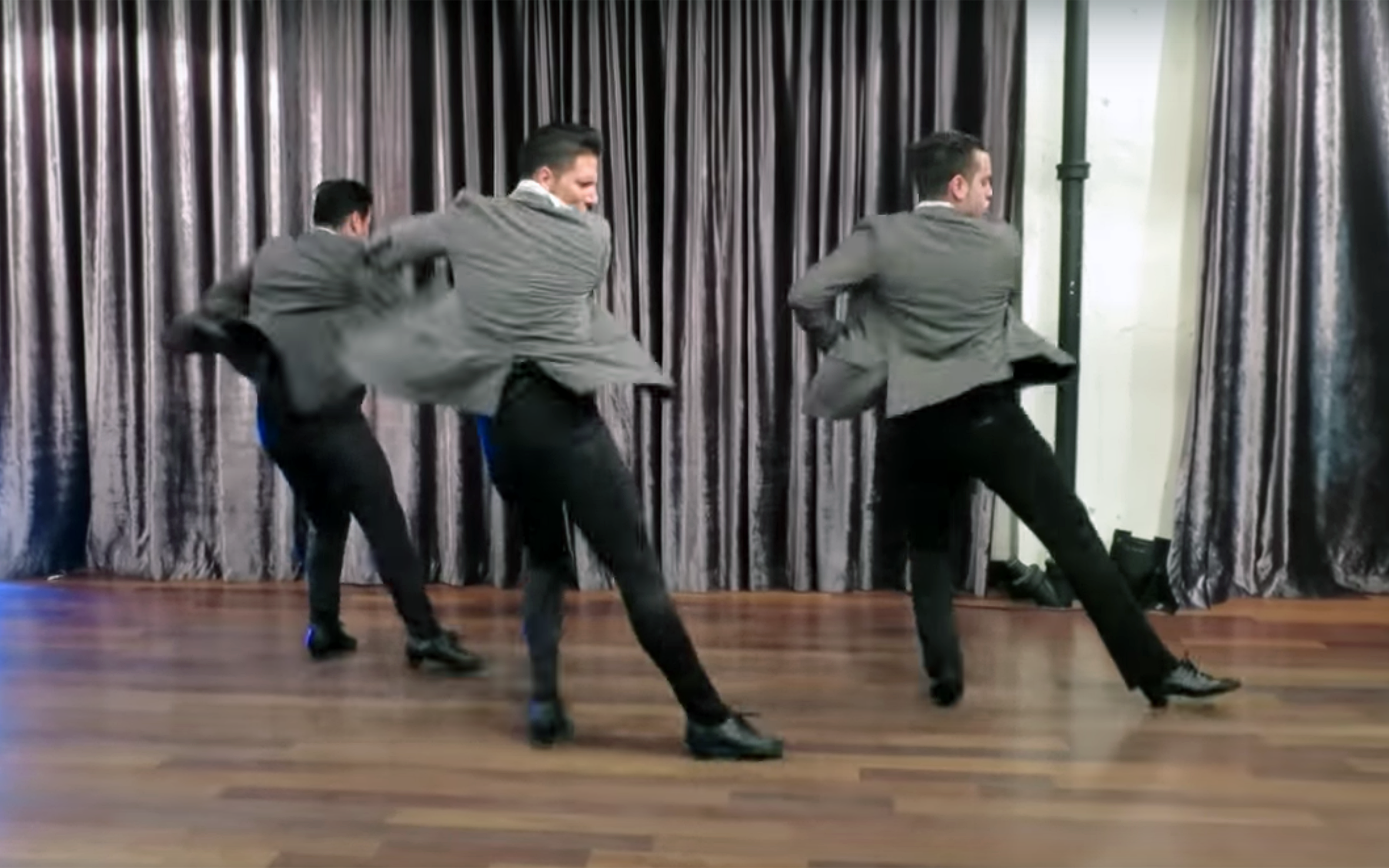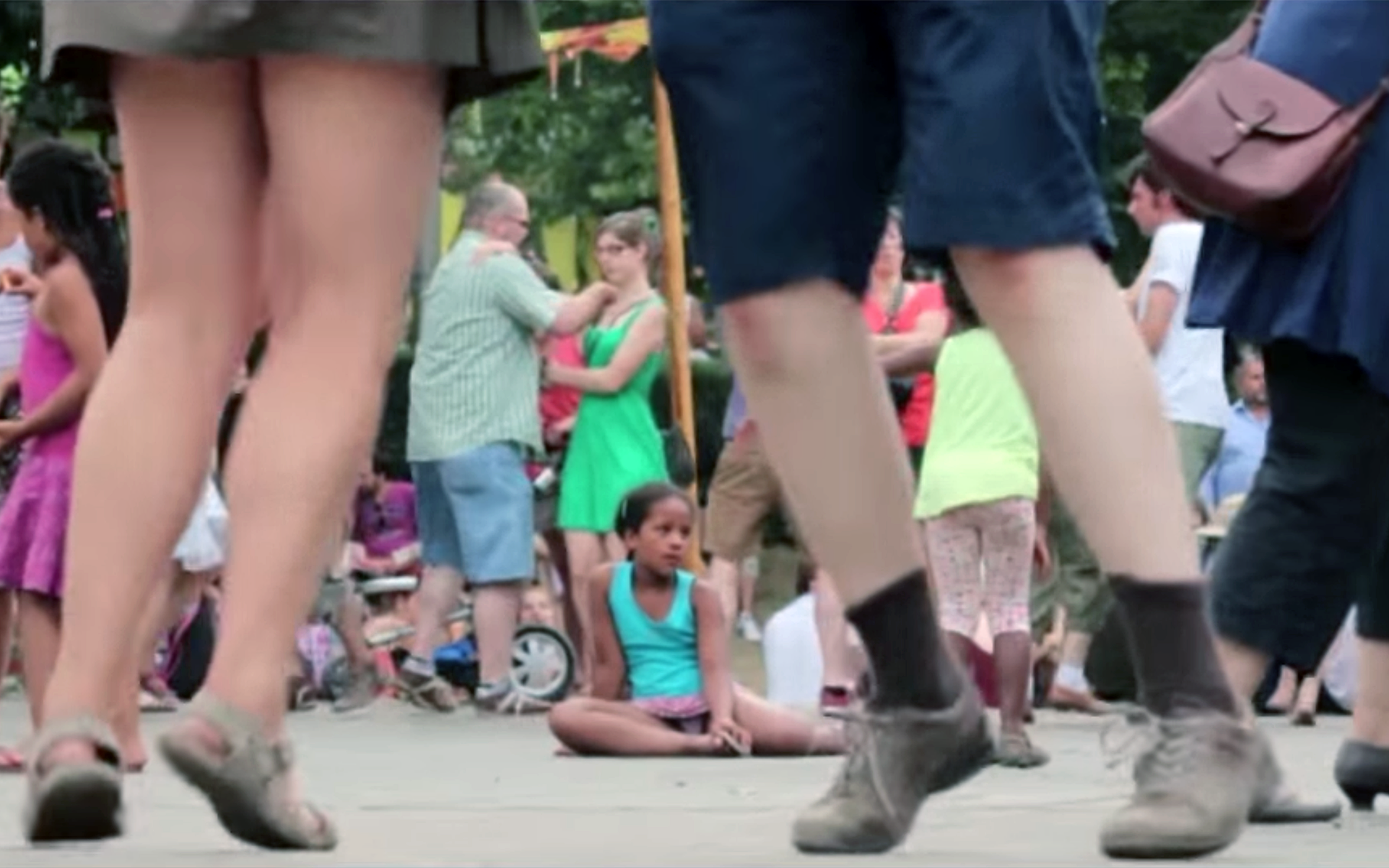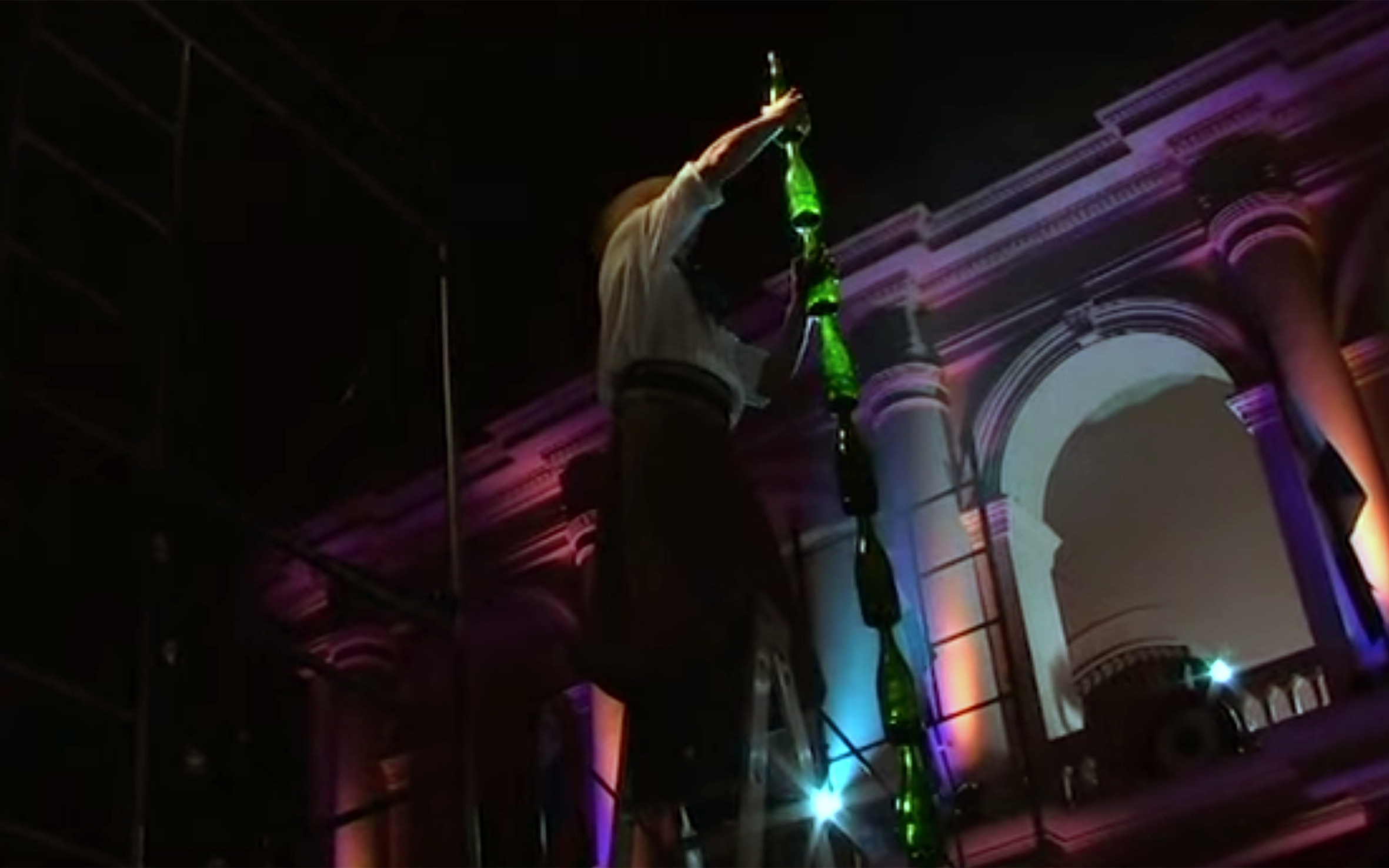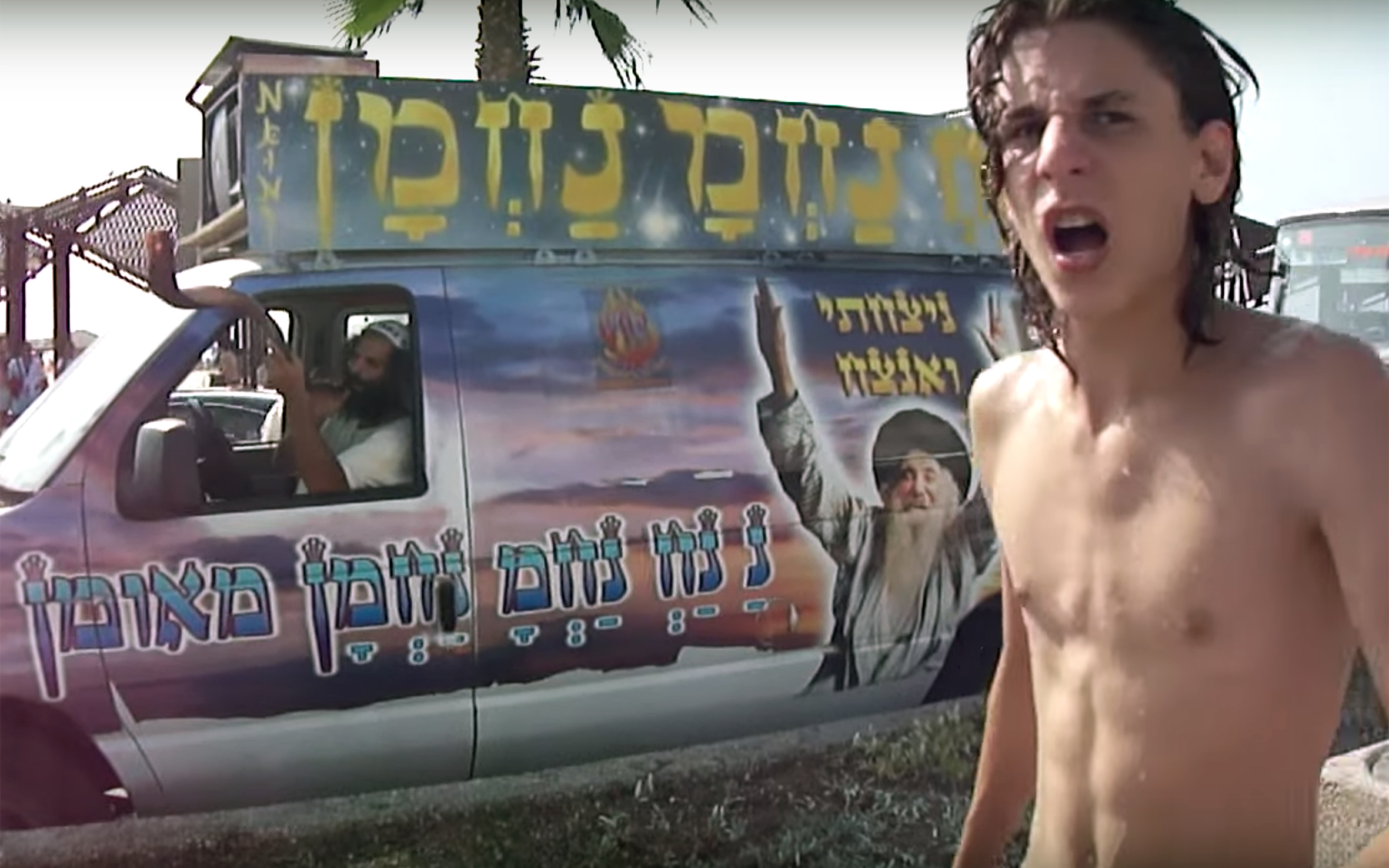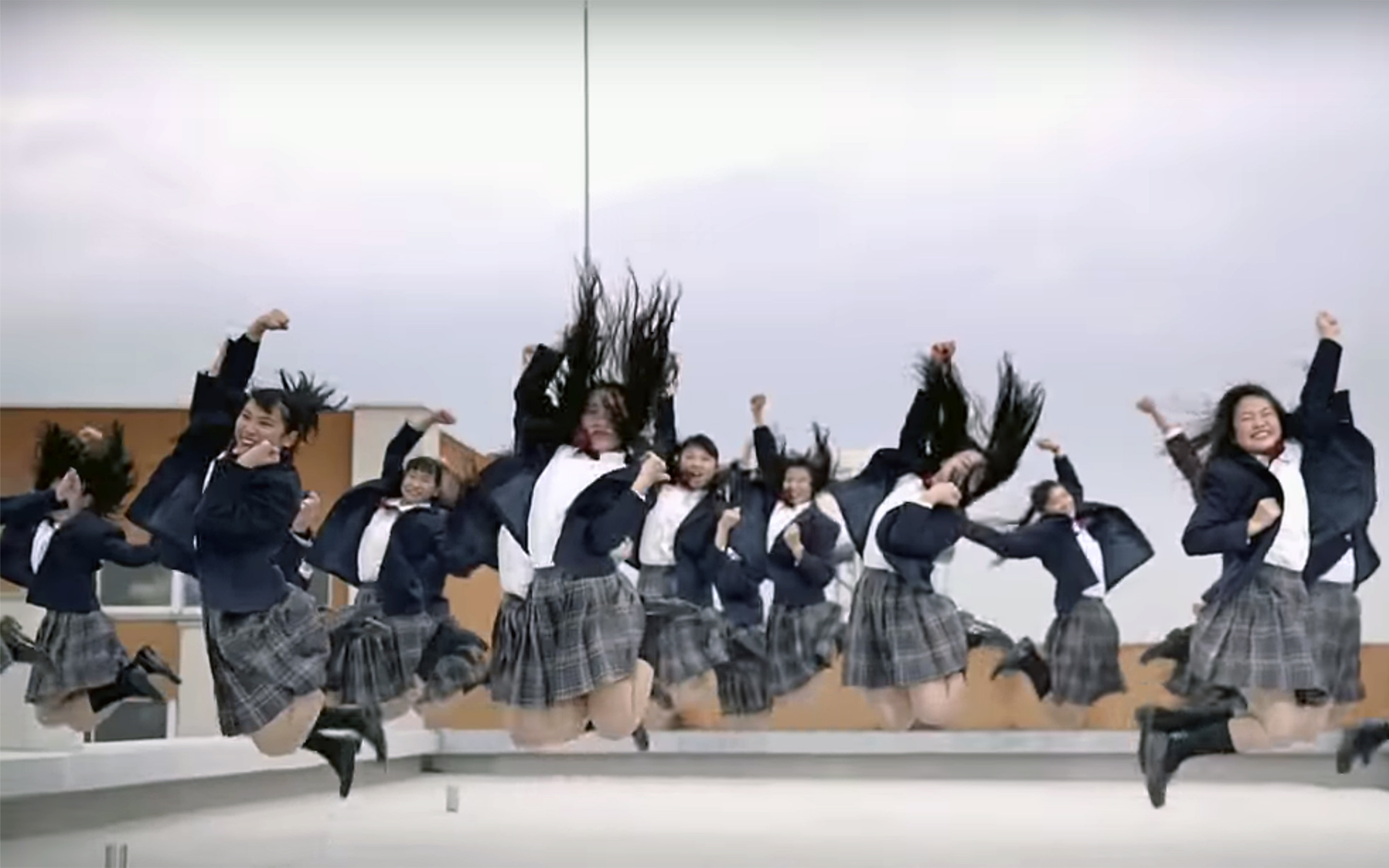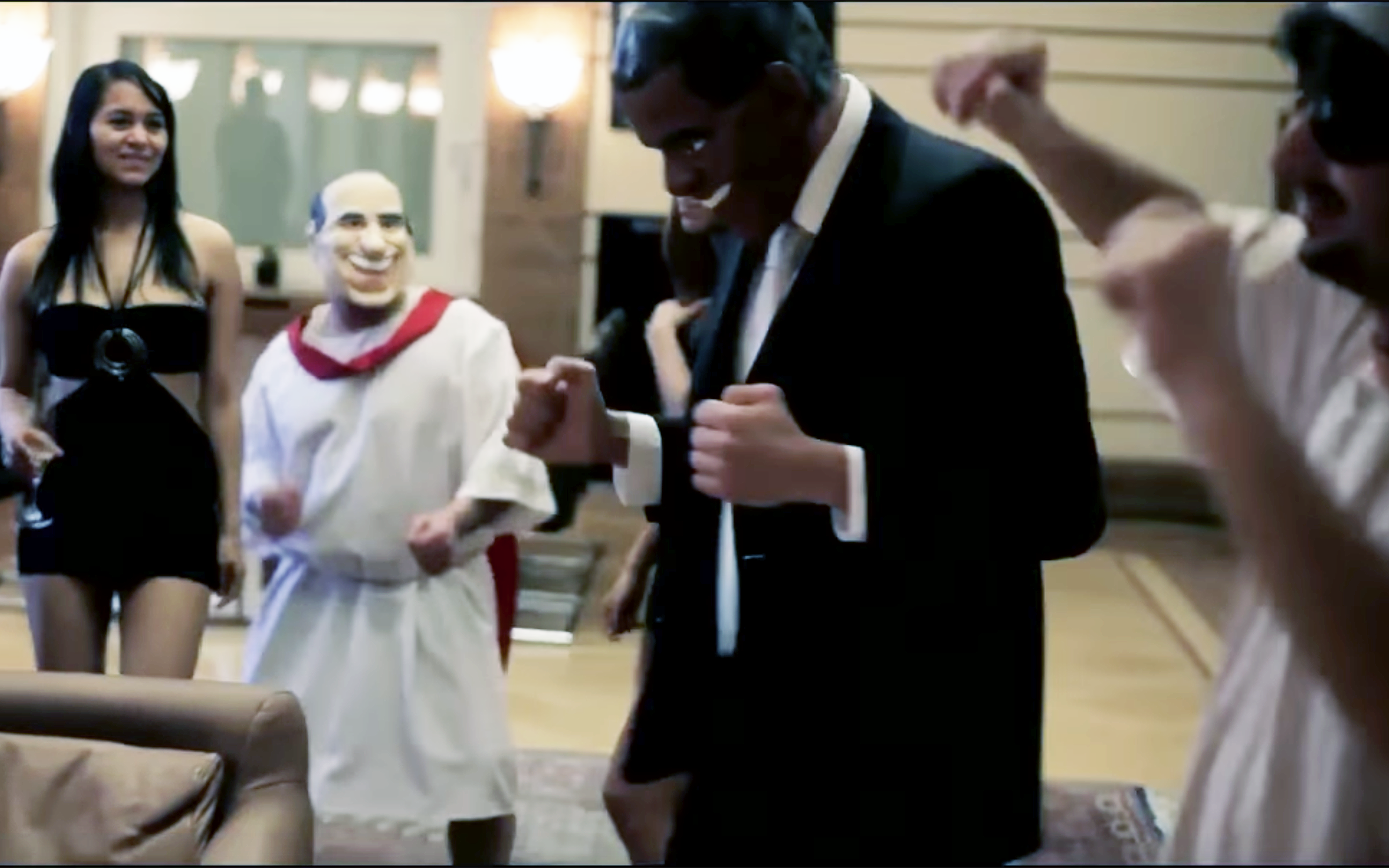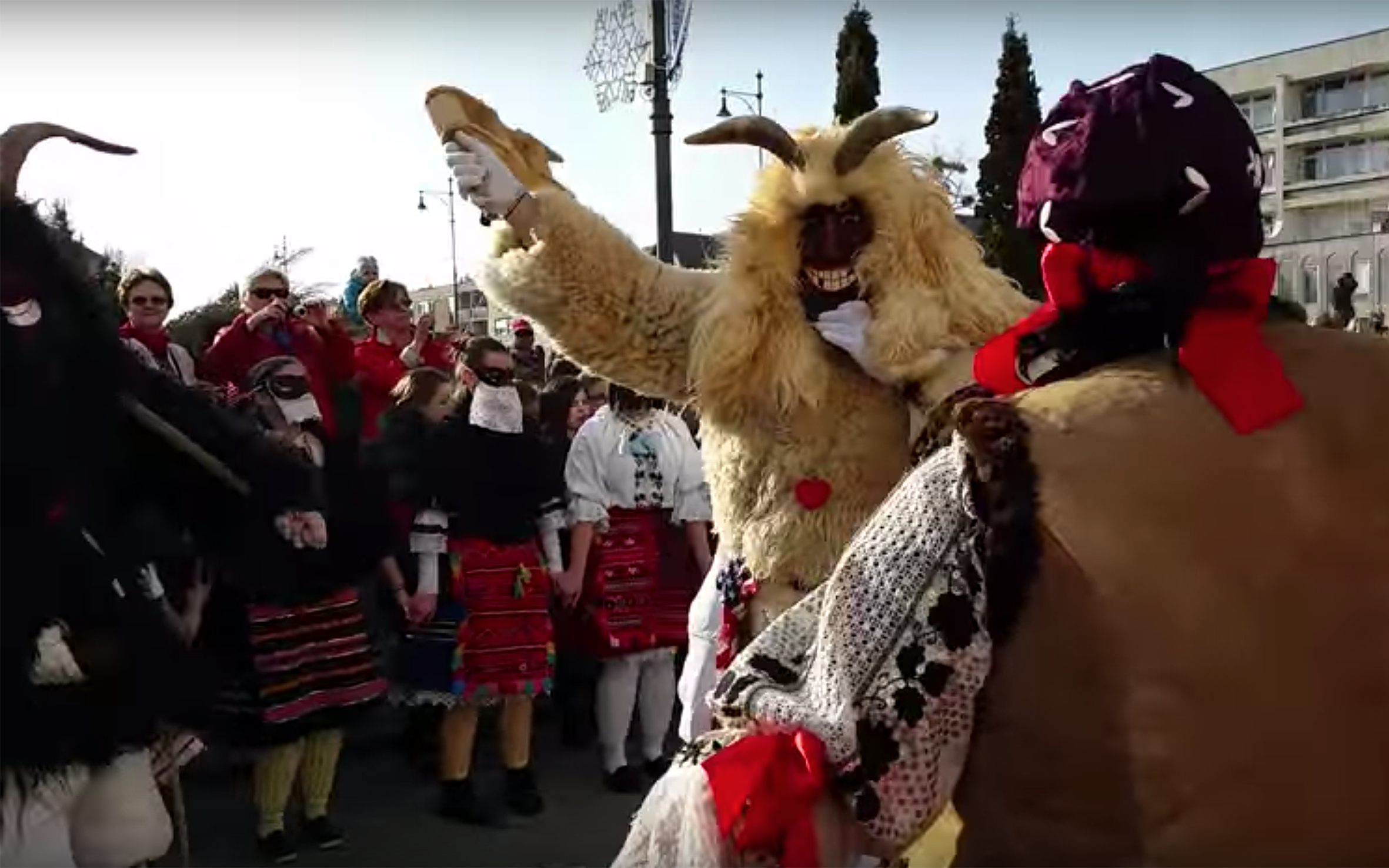52.Baagh Naach / India
BAAGH NAACH or TIGER DANCE is performed in Binka, Sonepur of Subarnapur district and Brahmapur and in some parts of Ganjam district in Odisha, India. It is performed in the month of Chaitra, the first month of a year in the Hindu calendar. This renowned dance style is a group dance performed by male dancers, who paint their body with yellow and black stripes, impersonating a tiger. Their postures and movements are energetic and swift in order to imitate the majestic predator. The dance is accompanied by the drums and bells and is commonly practised in certain festivals or special occasions.
53.Bara’a / Yemen
BARA’A is a group dance from Yemen, one of the several traditional outdoor dances. Bara’a dance literally means “a dagger dance”, where each of the dancers holds a dagger. It differs from tribe to tribe, with any number of men participating. It is accompanied by the beat of two drums and performed during religious and national holidays, the afternoons of wedding ceremonies, traditional cooperative work projects or to greet important guests. Dancers perform close together in an open circle. The leader and the better dancers position themselves near the middle. The basic step consists of a step-together-step-up, forward and backward, with a number of turns and knee bends. There are three segments of the dances, each with a faster tempo than the previous one.
54.Baba Karam / Iran
BABA KARAM is a very popular urban folklore dance that originated from Persia. It used to be a sad dance in the ancient, traditional form but with the passage of time, it has evolved into a contemporary style. It is a chain dance derived from a Sufi story whereby a servant at the court of the king falls in love with one of the harem girls and sings this song out of the grief of not being able to be with her. It used to be performed exclusively by men, but nowadays it is also performed by women. The dancers do a shoulder dance, wear black and white, and usually hang a Gamucha on the neck and use it during the dance. A contemporary form of chain dance developed in the 19th century, Baba Karam is also sometimes referred to as the Persian style of modern hip hop dance.
55.BACHATA / Dominican Republic
BACHATA is a dance that originated in the Dominican Republic. It is danced widely all over the world. The basics of the dance are three-step with a Cuban hip motion, followed by a tap including a hip movement on the 4th beat. The knees should be slightly bent so the performer can sway the hips easier. Movement of the hips is very important. It is a part of the soul of the dance. Most of the dancer’s movement is in the lower body up to the hips, and the upper body moves much less. Bachata is commonly known as a very sensual dance. It originated as a sort of “mating call”—if you were selected to dance, you were chosen as a mate, two dances with the same individual “sealed the deal”.
56.BADAWĪ DANCES / North Africa / Middle East
BADAWĪ DANCES are traditional dances performed by the Bedouin communities, nomadic herding peoples of the deserts. They have different variations depending on the country in which these communities live, yet they include similar elements. The most common dance is a simple communal dance, which is the chief element of all festivities and social gatherings.
57.Badhai / India
BADHAI is a popular dance on the occasions of birth, marriage, and festivals in the Bundelkhand region of Madhya Pradesh in India. Men and women dance vigorously to the tunes of accompanying musical instruments. The dancers cause quite a stir, using supple and acrobat-like movements and colorful attire.
58.Bagurumba / India
BAGURUMBA is a folk dance performed by the indigenous Bodo tribe in Assam and Northeast India. It is a traditional dance inherited from one generation to another. The Bodo women perform the Bagurumba dance with their colourful attire. It is accompanied by musical instruments such as kham (a long drum, made of wood and goat skin or other animal’s skin), sifung (flute, made of bamboo), jota (made of iron), serja (a bowed instrument, made of wood and animals skin), and gongwna (made of bamboo), tharkha (a piece of split bamboo). Bagurumba dance originates from nature.
59.Baile de congo / Panama
BAILE DE CONGO is an Afro colonial dance style from Panama that is characterized by its energetic steps and theatrical performance. The women dance swaying their hips in an almost erotic manner, using hands and feet to mark the man limits. The rhythm of drums, singing and applause invites everyone around to participate in the dance. It shows the history of black slavery and colonialism. It is considered the oldest dance in the Panama region.
60.BAILE DE DIABLITOS / Costa Rica / Panama
BAILE DE DIABLITOS is a part of the Diablitos ceremony that is present in various cultures in Central America, but mostly in Costa Rica and Panama. The ceremony is a theatrical performance and a dance that narrates the story of the colony, where the bull represents European culture and the “diablitos” represent indigenous spirits that defeat the bull.
61.Baile del cuadrado / Viral
BAILE DEL CUADRADO is a popular social media trend where the dance choreography is performed without stepping out of a square on the floor.
62.Bakalao / Spain
BAKALAO is a genre of electronic music and dance that emerged in Spain at the beginning of the 90s. The name comes from Valencia, where in 1985 in the record store Zic-Zac, the meeting point for DJ’s from the Valencian scene, someone said to one DJ: “This is Bakalao from Bilbao!”, and within a few weeks, every time someone heard a good song it was called “bakalao”. Currently, the term is used only in Spain to describe electronic music that originated from the mid-80s, with styles such as techno, EBM, or technopop. Little by little, electronic music evolved towards other rhythms such as house, new beat, and acid house. It is characterized by its repetitive rhythms. The drum machines, the samplers, and the synthesizer are also present like in the other electronic styles.
63.BACKAZ / JAMAICA / VIRAL
BACKAZ is a famous booty dance originating from a dance video to a song with the same name by Demarco, a Jamaican dancehall and reggae recording artist. It became a viral dance craze.
64.Bakiga DANCES / Uganda
BAKIGA DANCES are traditional dances of the Bakiga people of the Kigezi region in southern Uganda, such as Ekizino. The weather in this region is similar to that of many European mountain countries, and the region is often called the “Switzerland of Africa”. During colder seasons, Ekizino is the warm-up dance. Kigezi is a hilly region, the men who go out for farming early in the morning, must jump around for a while to get warm and also stretch their muscles after the hard work. Traditionally, the people also used to stamp the ground until they found signs of water. Therefore, this dance represents their jumping and stamping.
65.Baladi / Egypt
BALADI is a sort of undisciplined folk belly dance. It does not exactly follow classic belly dance and it is more intuitive and simple. Baladi means “of the country” and is a style of Egyptian folk dance from the early 20th century which is still very popular. It came about when farmers moved to the city and began dancing in small spaces. Egyptians have Baladi people, Baladi bread, Baladi rhythms, Baladi music and Baladi dance.
66.BALBOA / USA
BALBOA is a swing dance that originated in Southern California during the 1920s and with huge popularity during the 1930s and 1940s. The term “balboa” originally referred to a dance characterised by its close embracement and full body connection. It emphasises rhythmic weight shifts and lead-follow partnership. Dancers used to also dance swing, a dance characterised by twists, turns, and open-position movement. Over time, these two dances merged and became collectively known as Balboa. The original dance is now referred to as Pure Balboa, and the original swing dance is now referred to as Bal-Swing or LA Swing to differentiate it from other types of swing. Because of its emphasis on subtlety and partnering rather than flashy tricks, Balboa is considered more of a “dancer’s dance” than a “spectator’s”.
67.Balinese Dances / Indonesia
BALINESE DANCES are many forms of traditional dances for religious and artistic expression, originating and being performed in Bali, Indonesia’s only majority-Hindu area. Typically they are dynamic, technically complex, and make use of exaggerated hand and facial expressions. Wali dances are connected with Hindu ritual or are encouraged to bring the dancer into a state of trance or spiritual possession. Balih-balihan dances such as the Legong Kraton are intended for entertainment and artistic purposes.
68.BALL CULTURE / Global
BALL CULTURE / BALLROOM grew out of Harlem in the 1920s. It is historically run by and centered around LGBTQ people of color. These balls have been havens and safe spaces where queer folks could express their authentic selves free from the judgment and stigma of mainstream white-cis-hetero viewpoints and power positions. The ballroom community is broken up into houses, each house includes groups of people that serve as families or teams. The houses compete against each other in balls, where judges assign winners based on how well they can do Kiki, or Vogue dance, as well as their attitude level, costume, makeup, look, etc. The Most notable influence of ball culture on mainstream society is voguing. Ball culture spread all around the world and constantly gains a lot of popularity.
69.BALLET / Global
BALLET is a type of performance dance that originated during the Italian Renaissance in the 15th century and later developed into a classical dance form in France and Russia. It was created during King Louis XIV’s reign. The legend says that the king created a few movements himself. It has since become a widespread, highly technical form of dance with its own vocabulary based on French terminology. It is characterized by light, graceful movements and the use of pointe shoes with reinforced toes. Ballet has been globally influential and has defined the foundational techniques used in many other dance genres and cultures. It has been taught in various schools around the world, which have historically incorporated their own cultures and as a result, ballet has evolved in a number of distinct ways.
70.Ballroom dance / Global
BALLROOM DANCE is a set of partner dances developed in England, enjoyed both socially and competitively around the world. Because of its performance and entertainment aspects, ballroom dance is also widely enjoyed on stage, film, and television. It may refer, at its widest definition, to almost any type of partner dancing as recreation. With the emergence of dancesport in modern times, the term has become narrower and traditionally refers to the five International Standard dances: Waltz, Viennese Waltz, Tango, Foxtrot and Quickstep, and five International Latin style dances: Samba, Cha-cha, Rumba, Pasodoble, and Jive. The two styles, while differing in technique, rhythm and costumes, exemplify core elements of ballroom dancing such as control and cohesiveness.
71.BALLU TUNDU / Italy
BALLU TUNDU or BALLU BARDU is a traditional Sardinian folk dance which is typically danced in a closed or open circle. It was described as early as 1805. In northern and central Sardinia, the dance is lively and animated with leaps and agile movements and usually accompanied by a choir of three or more singers in the center of the circle. In other areas, it is done to launeddas and the shepherd’s sulittu but the accordion had also made its appearance by the 19th century. The introduction is in 2/4 time but the dance itself is done in 6/8.
72.BALOCH dance / Iran
BALOCH DANCES are performed by the Baloch people, who live mainly in the Balochistan region of the southeasternmost edge of the Iranian plateau in Pakistan, Iran, and Afghanistan, as well as in the Arabian Peninsula. They are mostly sword or stick dances.
73.BAMAYA / Ghana
BAMAYA is a popular social dance from the northern part of Ghana. It is noted for its gracefulness and controlled gaiety in expressive dance movements. “Bamaya” is a Dagbani word which literally means ‘the river or valley is wet’. The dance is mostly done by men who are dressed in feminine outfits, and the ensemble comprises a lead dancer, other dancers and drummers who also double as chorus singers and sing along with the dancers. Bamaya is performed during public events and functions.
74.Bandari / Iran
BANDARI, often referred as PERSIAN BELLYDANCE, is a chain dance indigenous to the southern and southwestern Bandar region of Iran down to Persian Gulf. It has been influenced by the African and Arabic music and dance, and is performed with accompanying Bandar music. The music is happy and rhythmic, and traditionally played by bagpipes and percussion instruments. Multiple dancers move rhythmically in various directions to the beat of the song. They wave their hands in a unique manner that resembles the cooperation of a group of fishermen at the sea. Banari is often performed at parties.
75.BANDLTANZ / Germany
BANDLTANZ, called also THE MAYPOLE DANCE or DANCE OF RIBBONS, is a German traditional dance of May 1st and a celebration of the arrival of spring. The men and women dance around a finely decorated Maypole (Maibaum), wrapping intertwined red and white ribbons around the pole as they go.
76.Banya / Suriname
BANYA is a dance style originating from Suriname. There are two styles of Banya: Nowtu Banya and Prisiri Banya. Banya used to be a social dance style of the Afro-Surinamese ancestors and was danced on the plantations during certain festive occasions. Nowadays Banya dance is no longer known as a social dance, but as a religious dance, part of the Banya Prey or Kabra Prey—a dance ritual in honor of the ancestors.
77.BAONOPSTEKKER / The Netherlands
BAONOPSTEKKER is a traditional dance from the eastern parts of the Netherlands. It is danced by individual dancers in a big circle, arm in arm. In the past people often danced in pubs. Before the actual dance could start, the room had to be cleared of people and furniture. Baonopstekker was supposed to clear the room of non-dancers.
78.BAR / Turkey
BAR is a folk dance from the eastern part of Anatolia, Turkey, performed in the open by groups of men and women. They dance side-by-side, hand, shoulder and arm-in-arm, but performances of women and men differ from each other. The principal instruments of bar dances are davul and zurna (shrill pipe). The dominant measures in bars are 5/8 and 9/8. Occasionally measures of 6/8 and 12/8 are also used.
79.Barbie Dance / Global
BARBIE DANCE is a dance style mostly performed by children who act like Barbie or twirling ballerina dolls. It allows a girl to control the choreography like a Barbie doll and to bend into a classic plié with her body spinning gracefully, causing her skirt to twirl.
80.Bardo Chham / India / Bhutan
BARDO CHHAM is a folk dance of Sherdukpens, a small community of West Kameng District of Arunachal Pradesh in India. It depicts scenes and ideas from the Buddhist book of the dead. Bhutanese Buddhists believe that after death humans are set to wander in the intermediary state known as bardo. Once they have crossed the bardic purgatory, they must face judgment by the Lord of Death. Bardo dance serves as a physical representation of the fate of those who have sinned and those who have been virtuous, and it is one of the most well-attended events at Paro’s annual Tsechu.
81.BaT Mitzvah Dance / Israel
BAT MITZVAH DANCE is one of the trends in recent years in Israel of dancing at the Bat Mitzvah celebration, which is a Jewish coming of age ritual for girls. It is most of the time an expensive production, sometimes accompanied by a professional dance team. The main thing is for the girl to feel like a princess.
82. BATUQUE / Cape Verde
BATUQUE is a celebratory dance originating from the archipelago of Cape Verde. It is performed mainly during festive occasions such as weddings, essentially for several hours. It is danced in a group mostly of women, dressed in white sleeveless short shirts that leave the navel exposed, and knee-long white trousers to boots. It is said that the Batuque was based on several other forms of African dances used as a template. Under the colonial rule of the Portuguese, Batuque as a musical genre and a dance form was banned since it was considered too “African”. Post-independence it was revived and regained popularity.
83.BAZOKIZO / Kenya
BAZOKIZO is a Christian dance song that won two awards in the local Groove Awards in Kenya in 2017. The music video produced by the singers composed of nothing but dance challenge styles filmed around Nairobi streets. This made the Bazokizo dance challenge very popular and many videos with people dancing Bazokizo started to pop up on the Internet.
84.BEAR DANCE / Bulgaria / Global
BEAR DANCE is a freestyle dance of a person wearing the bear costume and begging for money. It can be seen on streets in various countries around the world, for example in Bulgaria. It is also a dance performed by gay guys called bears—one of the LGBT communities of often larger or obese hairier men who project an image of rugged masculinity.
85.BEET DANCE / Marshall Islands
BEET DANCE is a traditional dance coming from Marshall Islands, an independent island chain, geographically and culturally part of the Micronesian area. It is influenced by Spanish folk dances. During the dance men and women side-step in parallel lines, creating a very difficult and complex rhythm.
86.BÈLÈ / Martinique
BÈLÈ is a folk dance and music from Martinique, Dominica, Haiti, and Guadeloupe. It may be the oldest Creole dance of the Creole French West Indian islands, and it strongly reflects influences from African fertility dances. It is performed most commonly during full moon evenings, or sometimes during funeral wakes. It is also popular in Saint Lucia. In Tobago, it is thought to have been performed by women at social events in the planters’ great houses, and the dress and dance style copied by the slaves who worked in or around these houses. Created in the early 17th century when slaves were working in cotton farms and were not allowed to speak their own language or play their music. The dance became their way to communicate and express themselves, without being seen by the European colonizers.
87.BELLY DANCING / Global
BELLY DANCING is considered to be the oldest folk dance in the world, which was originally a form of exercise and female bonding. It is an Arabic expressive dance originating in Egypt that emphasizes complex movements of the torso. It has evolved to take many different forms depending on the country and region, both in costume and dance style. For example, in Tunisia, it is characterized by sharp, horizontal twisting movements of the hips with flowing upper bodies, and is danced almost entirely on the toes with arms held in a “W” shape. It is seen at weddings and parties, and in the southern islands of Kerkennah and Djerba it is often performed with a clay water pot balanced on the head. It is also maybe the most famous and popular of Turkish dances, known as oriental dance.
88.BEMBA DANCES / Zambia
BEMBA DANCES are traditional tribal dances performed by the Bemba people living in the northeastern part of Zambia. A female initiation ceremony among the Bemba is called Chisungu. This rite of adolescence is intended to teach girls the traditional roles of women. A girl whose breasts have started to develop lives away from the group for six weeks to three months. Rites representing the duties of the girl as cook, gardener, hostess, and mother are performed. During the ceremony, there is a lot of drumming, dancing, singing, and drama.
89.BEN SKIN / Cameroon
BEN SKIN is a traditional dance and music of the Bamileke people in West Cameroon, in central Africa. The name Ben Skin comes from the word “to bend” (towards the front) and is linked to Manganbeu, another Bamileke dance style. It is played with drums and maracas, often made from soda cans, with vocal accompaniment. The Ben Skin dance gained popularity again in 1993 during economic depression. It was popularised in the early 1990s by André-Marie Tala who mixed it with afro-pop, funk, soul or afro-rap, and is sung in Bamileke, Douala, Ewondo, Bamoun, French or English. Today it has been adopted by the urban areas of Cameroon.
90.BESEDA / Czech Republic
BESEDA, called in full CZECH SALON DANCE BESEDA, is a traditional Czech salon-style dance for four couples. First it was danced in 1863. The set has four parts, each consisting of several excerpts of national songs and dances. The dance is 12 minutes long. It was created as a dance in the form of “čtverylka”.
91.Bété Dances / Ivory Coast
BÉTÉ DANCES are traditional dances performed by the Bété people from Ivory Coast, an ethnic group with strong cultural and artistic links to the Dan, the We (Gwere) and the Guro, among others. There are 93 distinct groups within the Bété polity and they have a diverse dance tradition. The most recognized is the ancient traditional hunter dance.
92.BHANGRA / India
BHANGRA is a traditional folk dance from the Indian subcontinent originating in the Majha area of the Punjab region, India, where farmers, who saw wheat growing, danced Bhangra to celebrate. Later it gained popularity amongst other regions and people started to widely perform it at weddings or New Year celebrations. In the 1980s Punjabis in the UK started playing Bhangra music by taking the folk sounds of desi instruments and mixing them with the Western tunes. It is usually a fast paced, very danceable music with high-pitched vocals.
93.Bharatanatyam / India
BHARATANATYAM may be the oldest classical dance tradition in India, originating from Tamil Nadu. Traditionally, it was a solo dance, performed exclusively by women, expressing South Indian religious and spiritual themes. Its theoretical foundations can be traced to the ancient Sanskrit text—Tamil epic Silappatikaram. It shows fixed upper torso, legs bent or knees flexed out combined with spectacular footwork, a sophisticated vocabulary of sign language based on gestures of hands, eyes, and face muscles. It is accompanied by music and a singer. Traditionally it was an interpretive narration of mythical legends from the Hindu texts. Modern stage productions of Bharatanatyam have incorporated technical performances, pure dance based on non-religious ideas, and fusion themes.
94.Bhenga / South Africa
BHENGA is a dance performed to gqom, the foot-stomping new sound of South Africa’s townships, minimalist house music from South Africa that is Durban’s answer to Chicago footwork. Unlike glossy, more mainstream kwaito house, which has lost much of its original appeal by recycling the more hackneyed elements of US pop and hip-hop, gqom is an authentic form of expression. It is dark and realistic, with an array of hollow drum sounds spun into jerky rhythms using FruityLoops software, and droning synths and ghostly one-note samples creeping in over the top. Bhenga engages all wavy arms, toe taps and wobbly knees. When you do bhenga, you aim to create this very intriguing image of flexibility. The moves are intended to attract an audience, drawing people into a circle as they writhe.
95.BIGUINE / Martinique
BIGUINE is a dance and music form, similar to slow rumba. It was popular in the 1930s, coming from the islands of Guadeloupe and Martinique, where in local Creole Beke or Begue means a white person, and Beguine is the female form. It is a combination of Latin folk dance and French ballroom dance and is a spirited but slow, close dance with a roll of the hips. At the beginning of the 19th century, it was prohibited because Western people judged it as too obscene. Later during the 1930s, it became famous in Paris, where it was a hot dance in the nightclubs. To dance Biguine, one needs a dancing partner that can guide you through the seven phases of the dance.
96.Bihu / India
BIHU is an indigenous folk dance from the Indian state of Assam related to the Bihu festival and an important part of Assamese culture. Performed in a group—Bihu dancers are usually young men and women—the dancing style is characterized by brisk steps and rapid hand movements. The traditional costume of dancers is colorful and centered around the red color theme, signifying joy and vigor.
97.Bike Dance / Global
BIKE DANCE is a type of funky, unrestricted freestyle dance style performed using a bicycle or a motorbike. It is danced by people who control their bicycles or motorbikes so well that they are able to make dance and acrobatic moves while riding.
98.BIKUTSI / Cameroon
BIKUTSI is a musical genre and a dancing style from Cameroon. It developed from the traditional styles of the Beti or Ewondo people, who live around the city of Yaoundé. It was popular in the middle of the 20th century in West Africa. The word “bikutsi” literally means “to beat the earth” or “let’s beat the earth”. The name indicates a dance that is accompanied by stomping the feet on the ground. It is played at all sorts of Beti gatherings, including parties, funerals and weddings. During Bikutsi, women dance and sing along with the balafon, and lyrics focus on relationships, sexuality and the lives of famous people. Traditional Bikutsi was often ironic in its content, as many modern Bikutsi songs still are.
99.BINASUAN / Philippines
BINASUAN is a Filipino folk dance from Bayambang, a town located in the southern part of Pangasinan province. It shows remarkable balancing skills of the dancers who turn rapidly in the circle moves by turning over and over on the floor, holding full wine glasses in each hand while performing balancing tricks. Wine may be used to fill the glasses, but it may be substituted with other liquids. In Pangasinan, Binasuan means “with the use of a drinking glass”. It is frequently performed as amusement at social gatherings such as birthdays, weddings and fiestas where it becomes a competition among dancers and also among non-dancers as to who can show the most adventurous balancing movements.
100.Biodanza / Chile
BIODANZA (neologism from the Greek “bio” (life) and the Spanish “danza” (dance), literally “dance of life”) is a system of self-development that uses music, movement and positive feelings to deepen self-awareness. It seeks to promote the ability to make a holistic link to oneself and one’s emotions and to express them. Biodanza also claims to allow one to deepen the bonds with others and nature and to express those feelings congenially. Its application consists of leading vivencias through music, singing, movements and group encounters. The Biodanza system was created in the 1960s by the Chilean anthropologist and psychologist Rolando Toro, and is now found in 54 countries.
101.Biyelgee / Mongolia
BIYELGEE is a dance style coming from Mongolia, with origins in nomadic culture. Almost all regions in Mongolia are populated by different ethnic groups that have their specific forms of Biyelgee dance. Choreography is rich and diverse since people living in different parts of the country express their feelings differently. Biyelgee is traditionally performed on the rather limited space before the hearth, so the dancers make practically no use of their feet. Instead, they use only the upper part of their bodies, and through their rhythmic movements express various aspects of their identities, such as sex, tribe, and ethnicity.
102.Blackpool Ballroom Dance / England
BLACKPOOL BALLROOM DANCE is a dance performed during the 8-day Blackpool Dance Festival—the world’s first and most famous annual ballroom dance competition of international significance, held in the Empress Ballroom at the Winter Gardens, Blackpool, England since 1920. It is also the largest ballroom competition in the world—2953 couples from 60 countries took part in the festival in 2013.
103.BMORE / USA
BMORE, also called BALTIMORE CLUB, is a breakbeat dance genre. A blend of hip hop and chopped, staccato house music was created in Baltimore, Maryland, the United States in the late 1980s by 2 Live Crew’s Luther Campbell, Frank Ski, Miss Tony, Scottie B., and DJ Spen. Baltimore Club is based on the 8/4 beat structure and includes tempos around 130 beats per minute. Much like the rave-era genre known as breakbeat hardcore, it sounds as if the music was intentionally hurried, as each song is made with a limited palette of sounds and is based on similar frameworks. Nowadays the style and its direct derivatives are exceptionally popular on the Internet due to music sharing websites such as SoundCloud, especially across the United States, Australia and Europe.
104.BOPPING / USA
BOPPING is the latest Chicago dance that was born on the Westside but really blossomed as a genre on the Southside. In its present form, it started showing up in the summer of 2012 at the parties thrown by the club promoter Wala Williams, who made his first Bopping-focused video back in July 2012. By the end of 2012, it was turning up regularly in local drill rap videos. At its core, Bopping consists of a few simple movements: a smooth shimmy down into a crouch and back, arm and knee action that is somewhere between flapping and twisting, and occasionally a step or two. It is fluid and playful, with a built-in pulse. At its most fundamental level, it is like bobbing your head to the beat, except using your whole body.
105.BOBOOBO / Ghana
BOBOOBO is a traditional dance beat from the Volta Region of Ghana, the Ketu district. A lot of people know and appreciate this dance beat, because of its creative communication between the dancers and the drummers.
106. BODU BERU / Maldives
BODUBERU is a dance coming from the Maldives. It is similar to some of the songs and dances found in East Africa. Most likely the music was introduced to the Maldives by sailors from the Indian Ocean region. Boduberu is performed by about 20 people, including three drummers and a lead singer. They are accompanied by a small bell, a set of drums also known as bodu beru, and an onugandu—a small piece of bamboo with horizontal grooves, from which raspy sounds are produced by scraping. The songs may be of heroism, romance or satire. The prelude to the song is a slow beat with emphasis on drumming and dancing. As the song reaches a crescendo, one or two dancers maintain the wild beat with their frantic movements ending in a trance at times.
107.Bolero / Spain
BOLERO is a type of 3/4 dance that originated in Spain in the late 18th century, a combination of the contradanza and the sevillana. It is danced by either a soloist or a couple. It is in a moderately slow tempo, and is performed to music which is sung and accompanied by castanets and guitars with lyrics of five to seven syllables in each of four lines per verse. It is in triple time and usually has a triplet on the second beat of each bar. There is also a second type of Bolero that originated in Cuba. The two dances are different in both origins and style.
108.BOLLYWOOD DANCE / India
BOLLYWOOD DANCE is a dance coming from the Bollywood films and is a synthesis of formal and folk Indian traditional music and dance traditions, in fusion with Middle Eastern techniques. The choreography of Bollywood dances takes inspiration from Indian folk dances, classical dances (such as Kathak) as well as disco, and from earlier Hindi film dances. The dances in older Hindi movies represented supposed dances of the common people, although they involved original choreography. Bollywood dances have evolved as a unique and energetic style. Since they are group dances, they are often used as joyful exercise music. This style of dance has also highly influenced international artists and appears in songs such as “Come and Get It” and EDM hit “Lean On”.
109.Bomba / Puerto Rico
BOMBA is a traditional music and dance style from Puerto Rico that was started by slaves brought to the island, who usually performed it on sugar plantations. It is a mixture of three different cultures—the African, Spanish, and Taino culture. The base rhythm is played by two or more drums. Bomba is a dialogue between the dancer and drummer.
110.Bonding Dance / Global
BONDING DANCE is a tool of social interaction that promotes cooperation essential for survival among early humans. Studies found that today’s best dancers share two specific genes associated with a predisposition for being good social communicators and that dancing has deep bonding abilities.
111.Bon-Odori / Japan
BON-ODORI, also called BON DANCE, is a style of dancing performed during Obon, a Japanese Buddhist custom to honor the spirits of one’s ancestors. The style of celebration varies in many aspects from region to region. Each region has a local dance with different music, thus the Bon dance looks and sounds different depending on the region. However, the typical Bon dance involves people lining up in a circle around a high wooden scaffold called “yagura” made especially for the festival. Some dances proceed clockwise and some counterclockwise around the yagura. At times, people face the yagura and move towards and away from it. Some dances simply proceed in a straight line through the streets of the town. Dance from a specific region can also depict the area’s history and specialization. Dancers perform the same dance sequence in unison.
112.Boogaloo / Global
BOOGALOO or BOOG STYLE is a loose and fluid dance style developed in 1975 by Boogaloo Sam. Partly inspired by movies and cartoons, it tries to give the impression of a body lacking bones. It utilizes circular rolls of various body parts, such as the hips, knees and head, as well as isolation and sectioning, like separating the rib cage from the hip. It also heavily uses angles and various steps and transitions to get from one spot to the next.
113. BOOGIE-WOOGIE / Global
BOOGIE-WOOGIE is a form of swing dance and blues piano playing. It was originally inspired by American rock ’n’ roll / lindy hop dancing of the 1950s, but gradually developed its own European style. It is a playful and improvised couple dance, often in medium or slightly fast tempo, with significant footwork based on musical interpretation. Boogie Woogie of today functions as a social dance, but sometimes is recognized even more as an established competition dance.
114.Boombal / Belgium
BOOMBAL is a relatively recent phenomenon of folk dance parties in Belgium, originating in the French Balfolk. They are a more social and enjoyable alternative to the individualistic dancing often seen in modern clubs and meant for everyone to have fun disregarding their dancing skills. Started in Ghent, Belgium, Boombal was first organized in September 2000 in an old furniture shop with about 5 couples taking part. Boombal typically consists of two parts: 1. initiation, lasting about an hour, with an instructor teaching various dances, such as Schottische, Gigues, and Bourrées, focusing on the dances that can be performed with two or more people; 2. party, with professional folk musicians playing live music and people performing dances they learned in the first part of the evening. A typical Boombal session lasts about two hours.
115.BORANKANA / Botswana
BORANKANA is a folk dance usually practiced or performed by the Bakwena tribe in the Kweneng District of Botswana. It is traditionally performed by both elderly and young people. According to history, Borankana was performed only during tribal activities. It is believed that historically only men and boys danced during the performances, whilst women sang and clapped hands.
116.Bottle dance / Paraguay
BOTTLE DANCE is a Paraguayan folklore dance, currently the only one danced individually always by a female dancer. It is said to originate from the promeseras—women who offered bottles of water to the peasants as a payment to the patron saint for received favors. Those bottles were worn on the head with great skill and balance. It is also believed that it could be a variation of the Galopa, danced by women with a pitcher. According to tradition, on one occasion a dancer broke the pitcher and had to dance with what she found to replace it, a bottle, originating a new dance.
117.BOURRÉE AUVERGNATE / France
BOURRÉE AUVERGNATE is a dance born in the Auvergne region of France. In the beginning, it was meant as a seduction dance. It is a two-person dance, but it can be practiced as a quartet as well. It has many varieties, characteristically danced with quick, skipping steps. The dancers occasionally wear wooden clogs to emphasize the sounds made by their feet.
118.BRAȘOVEANCA / Romania
BRAȘOVEANCA means “the dance of the city of Braşov”. In the past, Braşov residents called it Săseasca or “the dance of the Saxons” (Germans). Braşoveanca is a couple dance with variations, some of which are mixers, where the dancers change partners. Mixers are very rare in the Romanian repertoire. Changing partners together with the melody shows that the dance is an “adopted child” among Romanian dances.
119.BRÂUL / Romania
BRÂUL is a term used to describe a male chain dance from Romania. The name is used for several different regional families of dances that have little choreographic similarity. Nowadays, mixed and female versions of the dance are also performed.
120.BREAKDANCE / USA / Global
BREAKDANCE, also called BREAKING or B-BOYING/B-GIRLING, is an athletic style of street dance. With variations available, it mainly consists of four kinds of movement: toprock, downrock, power moves, and freezes. Breakdancing is typically set to hip hop, funk, and breakbeat music, although modern trends allow for much wider varieties of music along with certain ranges of tempo and beat patterns. It was created by the African American youth during the late 1960s and early 1970s. By the mid-70s, it began to spread and gain traction in other communities, while losing popularity with African Americans. In the 1990s Germany was one of the leading countries in breakdance.
121.BRESLOV Dance / Israel
BRESLOV DANCE is a dance performed by Breslov Hasidic Jews in Israel. They usually drive around the streets with a van that is full of grinning, bearded, long-haired men, mostly young, wearing an assortment of comfortable looking clothing and white, tassel topped yarmulkes. At intervals the van stops and the grinning men pour into the streets, dancing and twirling to mostly electronic music.
122.Broom Dancing / Canada / Global
BROOM DANCING is a casual dance form, as opposed to the more formal and competition-oriented form of Irish stepdance. The Métis people of Canada have a broom dancing tradition. This lively dance involves fast footwork and jumping. Jumping the broom is an African-American wedding tradition that originated in marriages of slaves in the United States in the 19th century. The style in various forms is also seen all around the world.
123.BUBBLEGUM DANCE / Global / Viral
BUBBLEGUM DANCE is a subgenre of Eurodance music, characterized by cute lyrics and happy sounds. It usually has a more pop sound than other Eurodance. The lyrics and style are often lighthearted, cheerful and not intended to be taken seriously. The dance is similar to the bubblegum pop music in that they both tend to have fun, childish subjects. The name was coined probably because of its similarities with the 1950s pop music, in which the female artists often appeared in photos with a pink bubblegum balloon in their mouth and exaggerated, wide and colourful skirts. Some subsequent pop styles have also been silly and cheerful, such as the 1980s pop music. It is common for bubblegum dance artists to use sexual or suggestive lyrics in their songs that are more appropriate for adult audiences.
124.Bubbling / Global
BUBBLING is a dance style with accompanying music that originated in the late 20th century. The bubbling music is a combination of hip-hop and R&B with a faster beat. Since not only bubbling music is played in most clubs and parties, the bubbling dancing has quickly spread to other styles, such as hip-hop, R&B, but also to a lesser extent to the faster types of music such as house and hardcore.
125.Bubbly Dance / Japan
BUBBLY DANCE was a dance performed by the Osaka Tomioka High School at the national convention “Dance Stadium” held on August 17, 2017, where it won the second prize. Bubbly stands as a reference to the high economic growth that happened in Japan from the 1960s to around 2000. This period is called “the bubble economy period” as it has disappeared like a bubble. Students performing the bubbly dance wore clothes from that time, which they borrowed from their parents. The bubbly dance video, choreographed and filmed by Akane, a graduate of the Osaka Tomioka High School, went viral and was watched on YouTube millions of times all over the world.
126.Buganda DANCES / Uganda
BUGANDA DANCES are traditional dances performed by the Buganda people from Uganda, such as Kiganda or Amaggunju dance. The beauty of Kiganda dance is in the graceful circular waist movements, elegant tiptoeing of the feet, and distinct hand gestures dictated by the flow of the song. Amaggunju dance is a royal dance performed for the purpose of entertaining a young king.
127.BUGG / Sweden
BUGG is a common dance style in Sweden, very popular on the dance floors with dansbands playing. It is a four-step dance performed at different paces (120-180 BPM). As a partner dance, it follows certain basic rules, but is essentially improvised, with the woman following the man’s lead. Swedish Bugg belongs to the swing dance family and closely resembles modern jive. There is also a variant called Double Bugg that is usually performed by one man and two women, but other combinations of three dancers may also appear. Today, the Bugg is one of the most popular social dances in Swedish dance clubs. It also provides a gateway into other local dance styles.
128.Bunga Bunga / Italy
BUNGA BUNGA is a type of pole and sexy dance associated with the Bunga Bunga sex parties organized by the former Italian Prime Minister Silvio Berlusconi and involving politicians and prostitutes. The expression was frequently used by the Italian and international press during the investigation surrounding Silvio Berlusconi’s underage prostitution charges, acquiring a quite different meaning as “an orgy involving a powerful leader”. Bunga Bunga was also said to be an underwater orgy with nude young women allegedly encircling the nude host and his friends in the swimming pool, an African-style ritual performed by 20 naked young women, or an erotic entertainment involving pole dancing and competitive striptease by skimpy costumed women in nurses’ outfits and police uniforms.
129.BUSÓJÁRÁS / Hungary
BUSÓJÁRÁS is an annual six-day celebration of the Šokci ethnic group living in the town of Mohács, Hungary, held at the end of the carnival season and finishing the day before Ash Wednesday. It features “busós”—people wearing traditional wooly costumes and wooden masks, and includes folk music, masquerading, parades, a bonfire and dancing. These traditional festivities were inscribed in 2009 on UNESCO’s Representative List of the Intangible Cultural Heritage of Humanity.
130.Busoga DANCES / Uganda
BUSOGA DANCES are traditional folk dances originating from the Busoga Kingdom in Uganda. One of their main characteristics is hip shaking. Among the most famous Busoga dances are Tamen Ibuga, associated with harvest celebrations, and Bigwala, performed during royal celebrations such as coronationsand funerals and, in recent decades, on social occasions. Bigwala music and dance have been inscribed on UNESCO’s List of the Intangible Cultural Heritage of Humanity.

